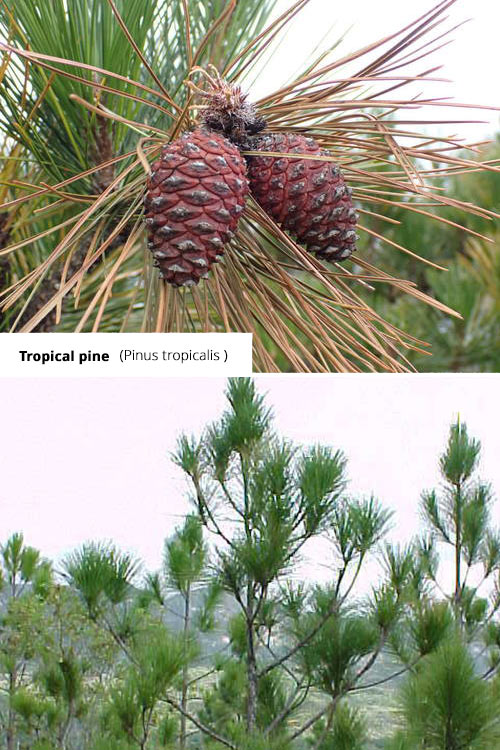Pine trees represent a remarkably varied and captivating collection of evergreen conifers, encompassing over 112 species worldwide.
We will explore the various types of pine trees found in Europe, the Mediterranean, West Asia, East Asia, and Southeast Asia, delving into their distinctive features, native habitats, and practical uses.
What we cover
ToggleFull list of Pine trees
You can click on any of these links to just right to the information on that particular pine tree on the page.
Europe, Mediterranean, West Asia
| Pinus brutia | Turkish pine |
| Pinus canariensis | Canary Island pine |
| Pinus cembra | Swiss pine |
| Pinus halepensis | Aleppo pine |
| Pinus heldreichii | Bosnian pine |
| Pinus mugo | Mountain pine |
| Pinus nigra | European black pine, Austrian pine |
| Pinus peuce | Macedonian pine |
| Pinus pinaster | Maritime pine |
| Pinus pinea | Stone pine |
| Pinus sylvestris | Scots pine |
East Asia, Southeast Asia
| Yakushima white pine | Pinus amamiana |
| Chinese white pine | Pinus armandii |
| Bhutan white pine | Pinus bhutanica |
| Lacebark pine | Pinus bungeana |
| Vietnamese white pine | Pinus dalatensis |
| Sikang pine | Pinus densata |
| Korean red pine | Pinus densiflora |
| Hainan white pine | Pinus fenzeliana |
| Huangshan pine | Pinus hwangshanensis |
| Khasi pine | Pinus kesiya |
| Korean pine | Pinus koraiensis |
| Krempf's pine | Pinus krempfii |
| Tenasserim pine | Pinus latteri |
| Luchu pine | Pinus luchuensis |
| Masson's pine | Pinus massoniana |
| Sumatran pine | Pinus merkusii |
| Taiwan white pine | Pinus morrisonicola |
| Japanese white pine | Pinus parviflora |
| Siberian dwarf pine | Pinus pumila |
| Chir pine | Pinus roxburghii |
| Siberian pine | Pinus sibirica |
| Qiaojia pine | Pinus squamata |
| Chinese red pine | Pinus tabuliformis |
| Taiwan red pine | Pinus taiwanensis |
| Japanese black pine | Pinus thunbergii |
| Blue pine or Bhutan pine | Pinus wallichiana |
| Guangdong white pine | Pinus wangii |
| Yunnan pine | Pinus yunnanensis |
Eastern Canada, Eastern United States
| Jack pine | Pinus banksiana |
| Sand pine | Pinus clausa |
| Shortleaf pine | Pinus echinata |
| Slash pine | Pinus elliottii |
| Spruce pine | Pinus glabra |
| Longleaf pine | Pinus palustris |
| Table Mountain pine | Pinus pungens |
| Red pine | Pinus resinosa |
| Pitch pine | Pinus rigida |
| Pond pine | Pinus serotina |
| Eastern white pine | Pinus strobus |
| Loblolly pine | Pinus taeda |
| Virginia pine | Pinus virginiana |
Western Canada, Western United States, Northern Mexico
| Whitebark pine | Pinus albicaulis |
| Rocky Mountains bristlecone pine | Pinus aristata |
| Knobcone pine | Pinus attenuata |
| Foxtail pine | Pinus balfouriana |
| Lodgepole pine | Pinus contorta |
| Coulter pine | Pinus coulteri |
| Colorado pinyon | Pinus edulis |
| Limber pine | Pinus flexilis |
| Jeffrey pine | Pinus jeffreyi |
| Sugar pine | Pinus lambertiana |
| Great Basin bristlecone pine | Pinus longaeva |
| Single-leaf pinyon | Pinus monophylla |
| Western white pine | Pinus monticola |
| Bishop pine | Pinus muricata |
| Ponderosa pine | Pinus ponderosa |
| Monterey pine, radiata pine | Pinus radiata |
| Texas pinyon, papershell pinyon | Pinus remota |
| Gray pine, foothill pine, digger pine | Pinus sabineana |
| Southwestern white pine | Pinus strobiformis |
| Torrey pine | Pinus torreyana |
Southwestern United States, Mexico, Central America, Caribbean
| Arizona pine | Pinus arizonica |
| Mexican white pine | Pinus ayacahuite |
| Caribbean pine | Pinus caribaea |
| Mexican pinyon | Pinus cembroides |
| Chiapas white pine | Pinus chiapensis |
| Cooper's pine | Pinus cooperi |
| Cuban pine | Pinus cubensis |
| Potosi pinyon | Pinus culminicola |
| Michoacan pine | Pinus devoniana |
| Durango pine | Pinus durangensis |
| Apache pine | Pinus engelmannii |
| Douglas pine | Pinus douglasiana |
| Gregg's pine | Pinus greggii |
| Hartweg's pine | Pinus hartwegii |
| Herrera's pine | Pinus herrerae |
| Jalisco pine | Pinus jaliscana |
| Johann's pinyon | Pinus johannis |
| Lawson's pine | Pinus lawsonii |
| Chihuahua pine | Pinus leiophylla |
| Lumholtz's pine | Pinus lumholtzii |
| Pinus luzmariae | Pinus luzmariae |
| Pinus maximartinezii | Big-cone pinyon |
| Thinleaf pine | Pinus maximinoi |
| Montezuma pine | Pinus montezumae |
| Nelson's pinyon | Pinus nelsonii |
| Hispaniolan pine | Pinus occidentalis |
| Egg-cone pine | Pinus oocarpa |
| Patula pine | Pinus patula |
| Orizaba pinyon | Pinus orizabensis |
| Weeping pinyon | Pinus pinceana |
| McVaugh's pine | Pinus praetermissa |
| Pringle's pine | Pinus pringlei |
| Smooth-bark Mexican pine | Pinus pseudostrobus |
| Parry pinyon | Pinus quadrifolia |
| Rzedowski's pine | Pinus rzedowskii |
| Chihuahua white pine | Pinus strobiformis |
| Tecun Uman pine | Pinus tecunumanii |
| Teocote pine | Pinus teocote |
| Tropical pine | Pinus tropicalis |
Europe, Mediterranean, West Asia
Europe, the Mediterranean, and West Asia are home to a diverse array of types of pine trees, each with its own unique characteristics. From the heat and drought-tolerant Turkish pine to the umbrella-shaped crown of the Stone pine, this region boasts various species with fascinating features.
Pinus brutia - Turkish pine
Native to Turkey, the Turkish pine (Pinus brutia) is a heat and drought-tolerant tree known for its red-brown bark and two needles per bundle. This striking species differs from other pines like the ponderosa pine, which hails from North America.
One notable subspecies, the Eldarica pine, boasts increased density, an upright form, and heightened tolerance for heat, wind, and drought. With leaves growing in groups of two and seed cones ranging from two to three and a half inches long, the Turkish pine is a captivating addition to any landscape.
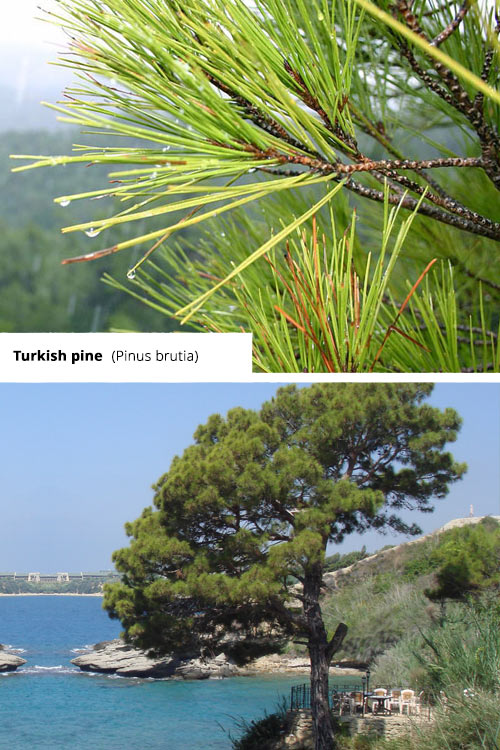
Pinus canariensis - Canary Island pine
The Canary Island pine (Pinus canariensis) is an evergreen tree native to the outer Canary Islands. It has the following characteristics:
- Bright green leaves that can reach lengths of up to 12 inches
- Thick bark with a reddish-brown color and shallow grooves
- Seed cones that can reach up to 9 inches in length, making for an impressive display.
However, the Canary Island pine is not cold-tolerant and thrives in a variety of soil types, making it well-suited for USDA growing zones 9-11.
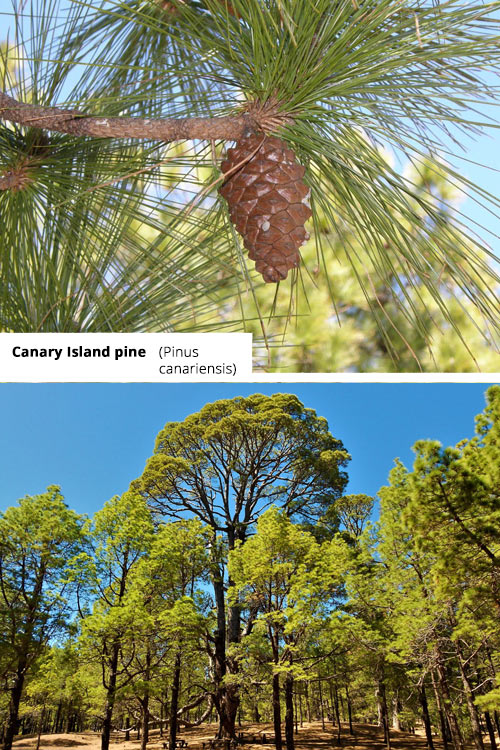
Pinus cembra - Swiss pine
The Swiss pine (Pinus cembra), native to the European Alps, is a slow-growing tree with dark green needles and large cones. This species is often used for carvings, interior wood paneling, and furniture due to its antibacterial properties. Unlike the sand pine, which is native to the southeastern United States, the Swiss pine thrives in the colder Alpine climate.
The large, edible seeds of the Swiss pine are also a source of food, making this tree not only an attractive addition to the landscape but also a practical one.
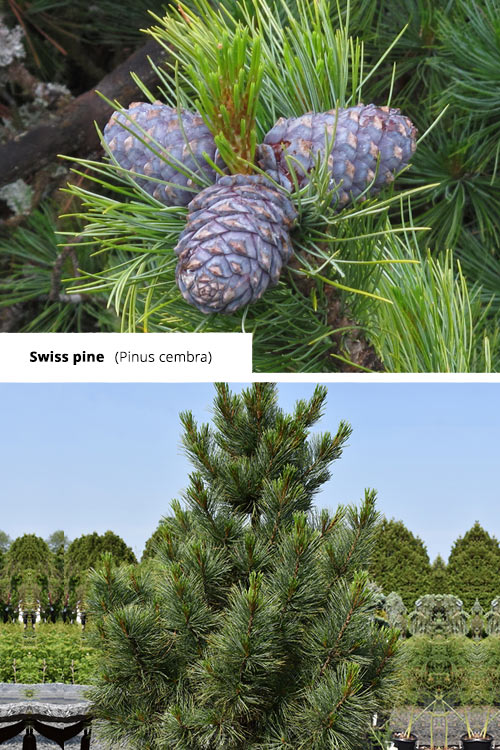
Pinus halepensis - Aleppo pine
The Aleppo pine (Pinus halepensis) is a highly invasive tree native to the Mediterranean region, characterized by its greyish-green leaves and grey-brown bark. This species can live for approximately 150-200 years, and its prevalence in certain areas has led to concerns about its impact on local ecosystems.
Despite its invasive nature, the Aleppo pine remains an interesting and distinctive species worth exploring.
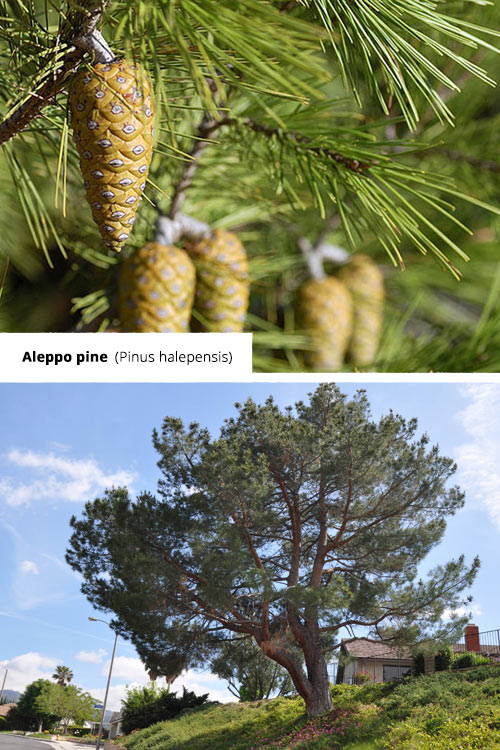
Pinus heldreichii - Bosnian pine
Slow-growing and native to the Balkan Peninsula, the Bosnian pine (Pinus heldreichii) boasts dark green needles and large cones. This species is often used as an ornamental tree in parks and gardens, as well as for timber and fuel.
With its unique features and practical applications, the Bosnian pine is a fascinating addition to the world of pine trees.
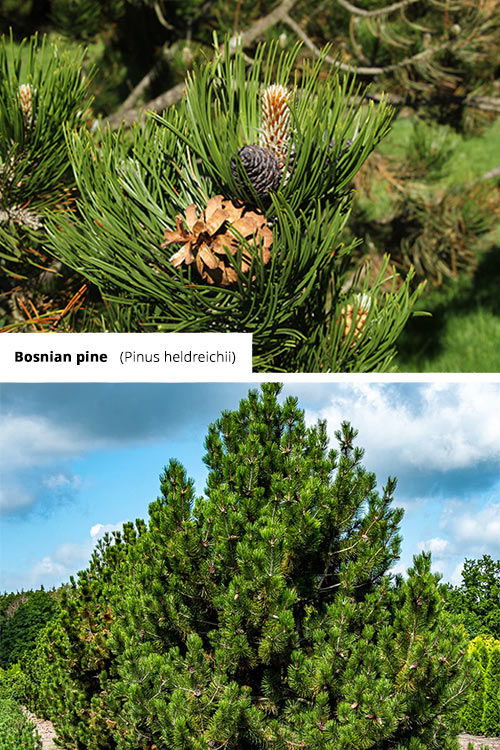
Pinus mugo - Mountain pine
The Mountain pine (Pinus mugo) is a small, shrubby tree native to the European Alps, unlike the sugar pine which is native to North America. This species is characterized by its dark green needles, reddish-brown bark, and short stature. Found in rocky slopes and other challenging environments, the Mountain pine is a testament to the resilience and adaptability of these remarkable trees.
The Mountain pine is a hardy species, able to survive in harsh conditions and thrive in harsh conditions.
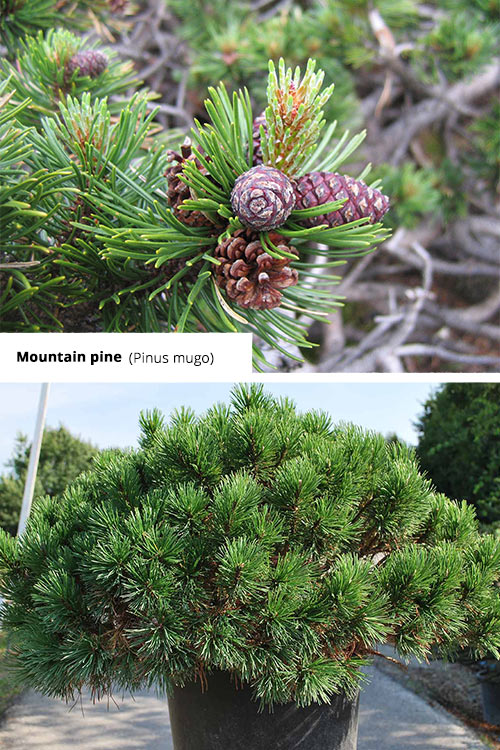
Pinus nigra - European black pine, Austrian pine
European black pine, also known as Austrian pine (Pinus nigra), is a non-invasive tree that can grow up to 100 feet tall and is native to both Europe and Asia. This species has two densely tufted needles per bundle, and its wood has a wide range of uses, from construction to furniture making.
The European black pine is a versatile and attractive species, worthy of admiration and appreciation.
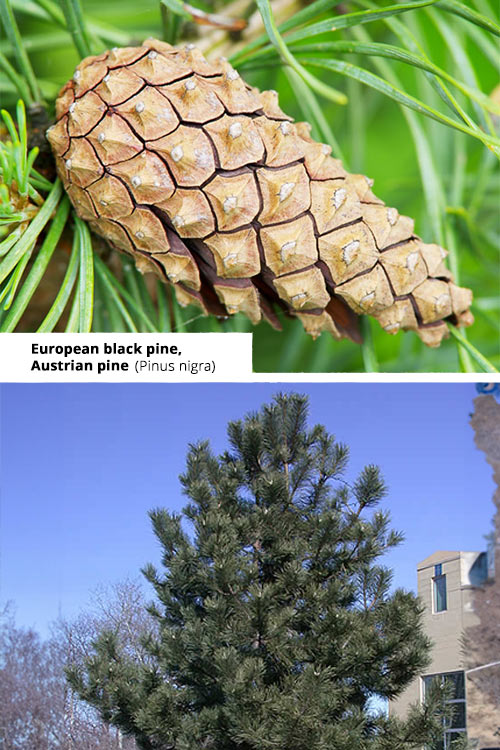
Pinus peuce - Macedonian pine
The Macedonian pine (Pinus peuce) is a slow-growing tree native to the Balkan Peninsula, with dark green needles and large cones. This species is often used as an ornamental tree in parks and gardens due to its striking appearance.
In addition to its beauty, the Macedonian pine also has practical uses, with its wood being employed for various purposes, including construction and furniture making.
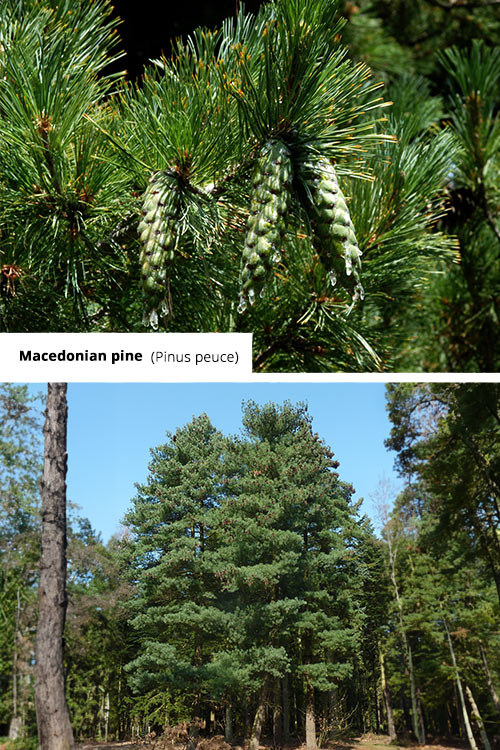
Pinus pinaster - Maritime pine
The Maritime pine (Pinus pinaster) is a fast-growing tree native to the Mediterranean region. This species has dark green needles and large cones, making it an attractive addition to any landscape.
The wood of the Maritime pine is used for various purposes, including construction and furniture making, while its bark contains a resin that is used in the production of turpentine.
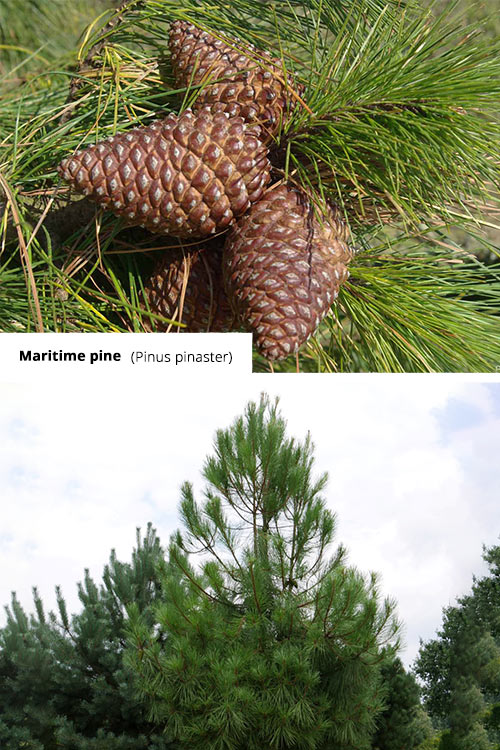
Pinus pinea - Stone pine
The Stone pine (Pinus pinea) is a medium-sized tree native to the Mediterranean region. It is known for its:
- Umbrella-shaped crown
- Edible pine nuts
- Grey-brown bark
- Long needles
The Stone Pine is an attractive addition to any landscape, and its seeds are a popular food source in many Mediterranean cuisines.
With its unique appearance and practical uses, the Stone Pine is a fascinating species to explore.
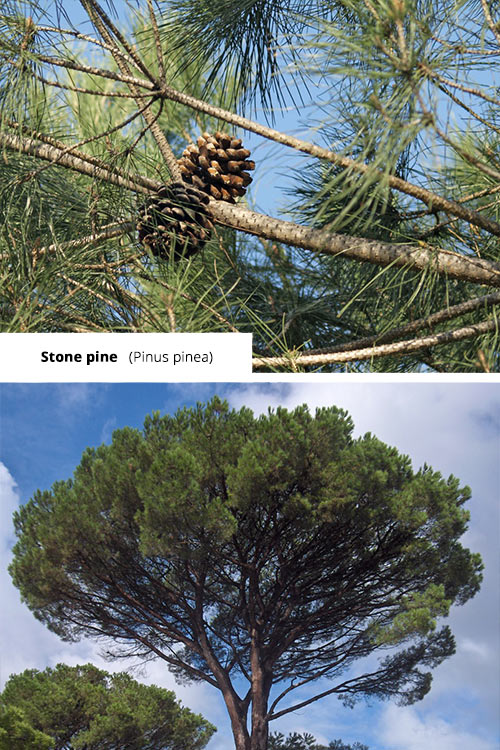
Pinus sylvestris - Scots pine
The Scots pine (Pinus sylvestris), a type of pine tree, is a fast-growing tree native to Europe and Asia, with blue-green stiff leaves and red-brown bark. This species is often cultivated as a Christmas tree, although other species such as Norway spruce, balsam fir, and spruce pine are more commonly used for this purpose.
The Scots pine is a versatile and attractive species, with uses ranging from timber production to landscaping.
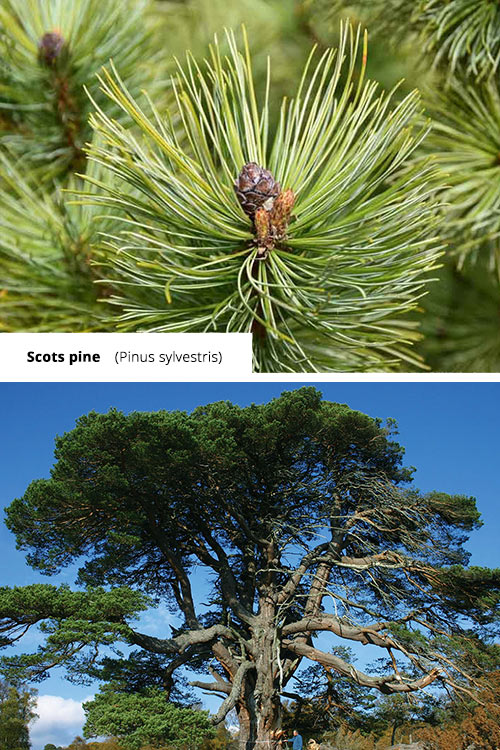
East Asia, Southeast Asia
Continuing our journey, we will now explore the fascinating world of pine trees native to East Asia and Southeast Asia. This region is home to an incredible diversity of pine species, each with its own unique characteristics and adaptations to their native environments.
From the rare Yakushima white pine to the vibrant Korean red pine, these trees offer a fascinating glimpse into the botanical wonders of Asia.
Pinus amamiana - Yakushima white pine
The rare Yakushima white pine (Pinus amamiana) is native to southern Japan, specifically the islands of Yakushima and Tanegashima. This species is characterized by its dark green needles and large cones. Its unique features make it an interesting and valuable addition to any landscape.
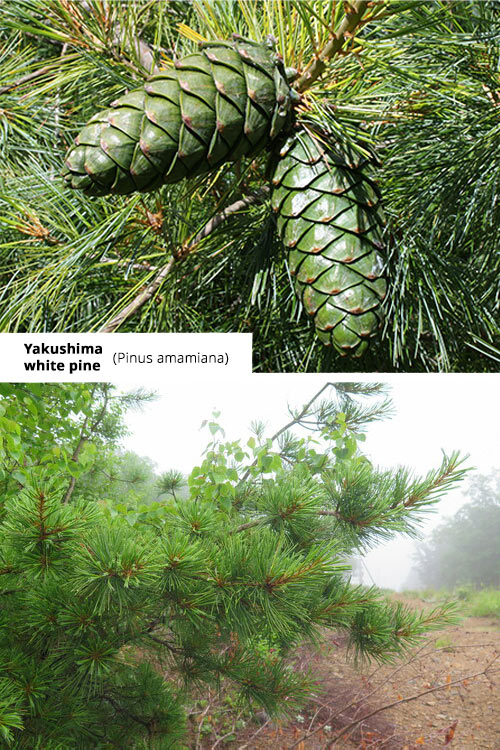
Pinus armandii - Chinese white pine
The Chinese white pine (Pinus armandii) is a medium-sized tree native to China, characterized by its long, blue-green needles and large cones containing edible seeds. However, it is important to note that these seeds can cause pine mouth syndrome, a metallic taste that can last for several weeks.
Despite this, the Chinese white pine is a fascinating species with a variety of practical uses. It is often used as an ornamental tree, and its wood is used for furniture.
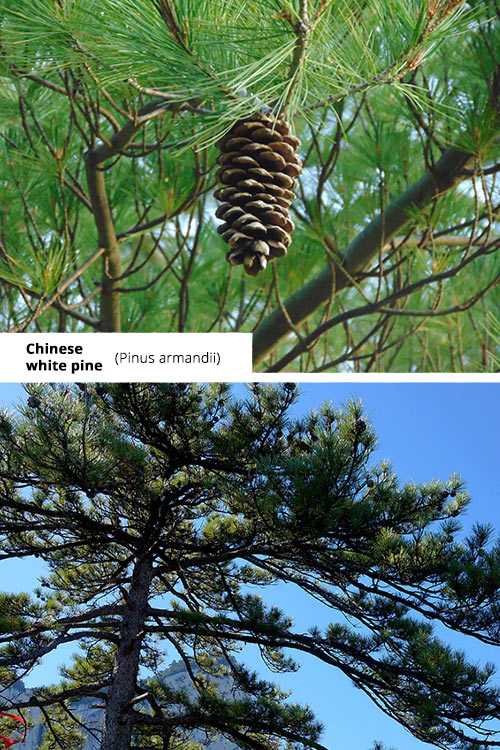
Pinus bhutanica - Bhutan white pine
The Bhutan white pine (Pinus bhutanica) is a medium-sized tree native to Bhutan and adjacent parts of northeast India. This species is characterized by its dark green needles and large cones, as well as its economic advantages, such as oil that can be used for consumption, timber, and incense stick powder.
The oil from the Bhutan white pine can be used for a variety of purposes, including for a variety of purposes.
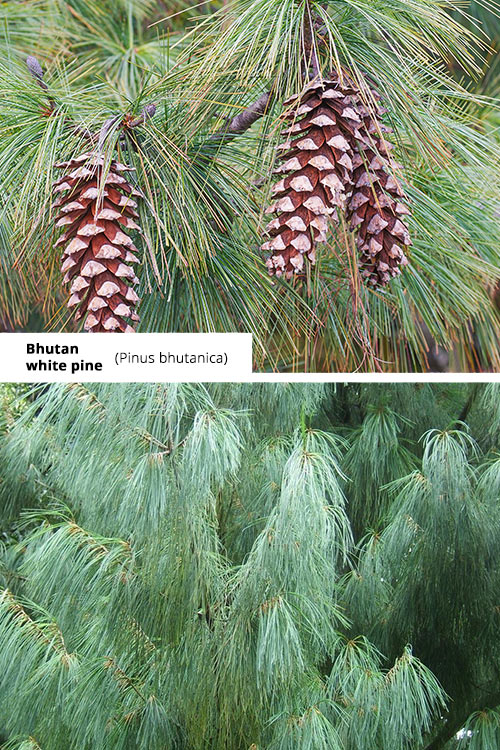
Pinus bungeana - Lacebark pine
The Lacebark pine (Pinus bungeana) is a slow-growing conifer native to China, known for its eye-catching white, metallic, and textured bark. This species is often cultivated in the Orient for its attractive bark and can be observed on the grounds of Buddhist temples, similar to the limber pine and loblolly pine in other regions.
With its unique features and cultural significance, the Lacebark pine is a fascinating addition to any landscape.
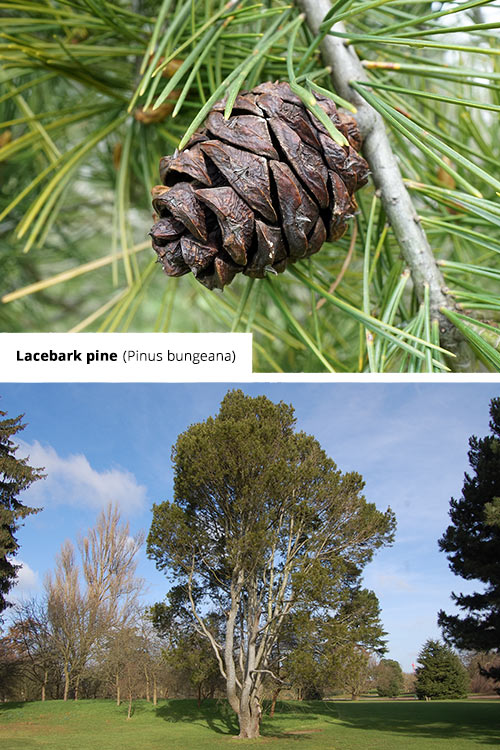
Pinus dalatensis - Vietnamese white pine
The Vietnamese white pine (Pinus dalatensis) is a medium-sized tree native to Vietnam, characterized by its dark green needles and large cones. This species is often used for timber and fuel, as well as for decorative purposes.
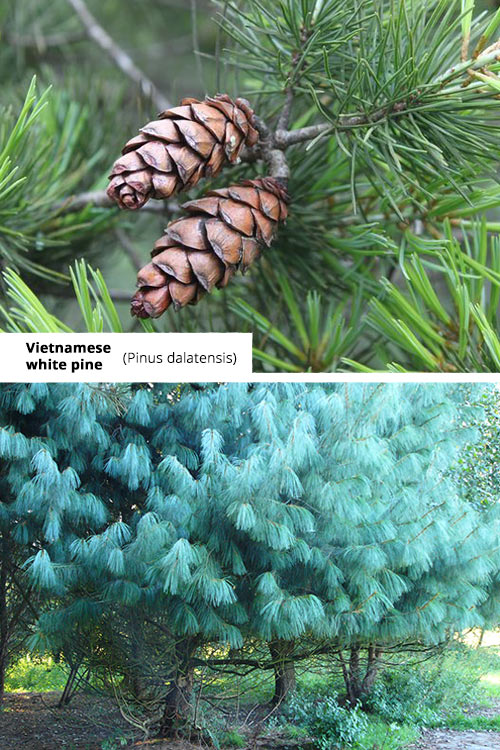
Pinus densata - Sikang pine
The Sikang pine (Pinus densata) is a medium-sized tree native to China, characterized by its dark green needles and large cones. This species is known for its rapid rate of growth and adaptability to a variety of soil types and climates.
It is a popular choice for landscaping and reforestation projects due to its hardiness.
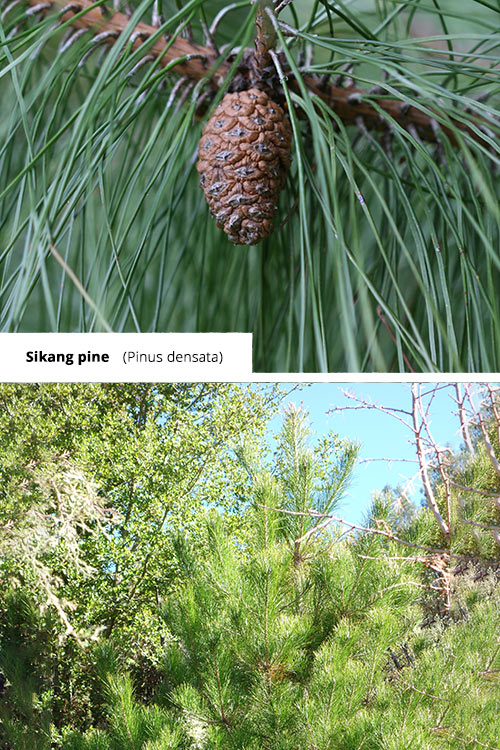
Pinus densiflora - Korean red pine
The Korean red pine (Pinus densiflora) is a medium-sized tree native to Korea, characterized by its dark green needles and large cones. This species is often used for timber and fuel, as well as for decorative purposes.
It is a popular choice for landscaping, as it is relatively easy to maintain and can be used for landscaping.
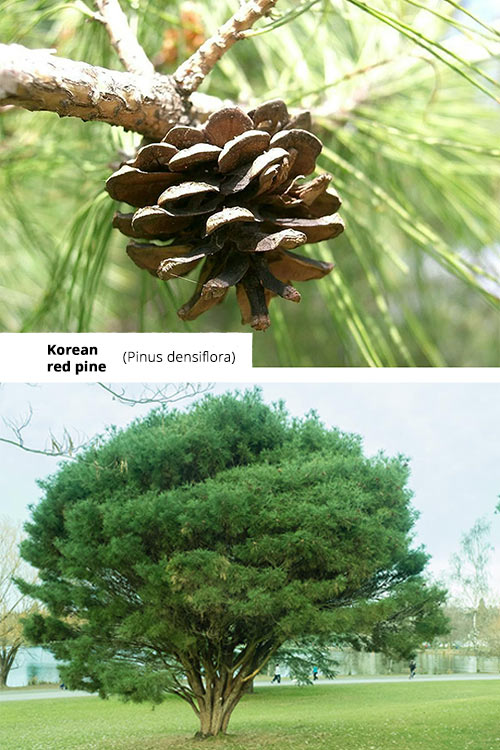
Pinus fenzeliana - Hainan white pine
The Hainan white pine (Pinus fenzeliana) is a medium-sized tree native to China, characterized by its dark green needles and large cones. This species is often used for timber and fuel, as well as for decorative purposes.
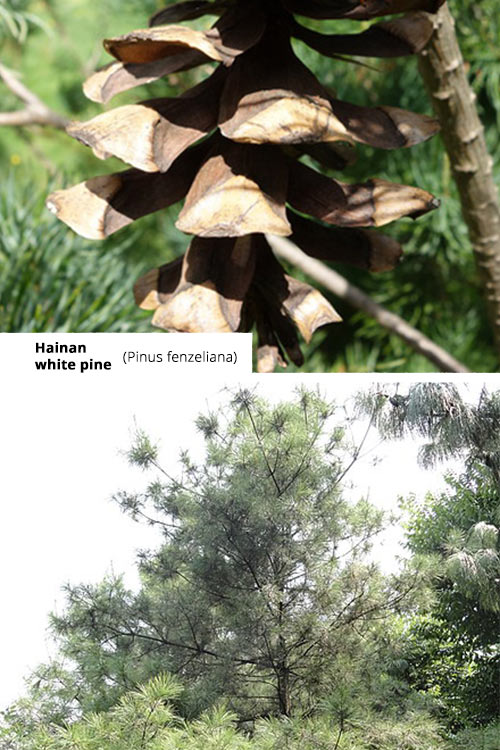
Pinus hwangshanensis - Huangshan pine
The Huangshan pine (Pinus hwangshanensis) is a medium-sized tree native to China, characterized by its dark green needles and large cones. This species is often used for timber and fuel, as well as for decorative purposes.
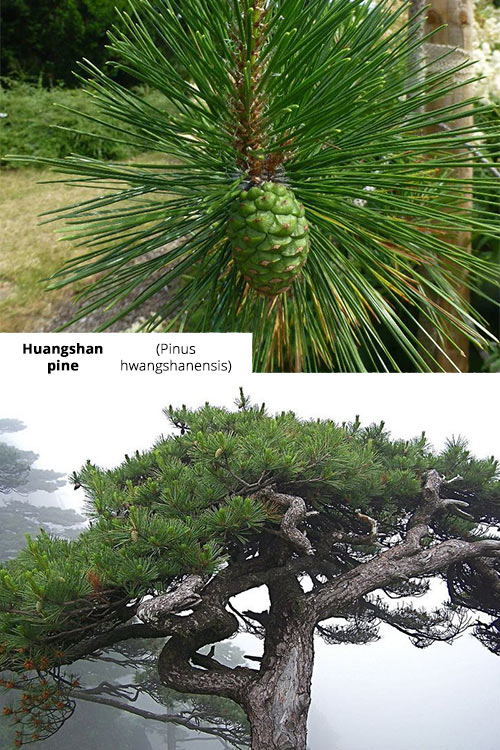
Pinus kesiya - Khasi pine
The Khasi pine (Pinus kesiya) is a medium-sized tree native to India, characterized by its dark green needles and large cones. This species is often used for timber and fuel, as well as for decorative purposes.
It is a popular choice for landscaping, as it is relatively easy to maintain and can be used for landscaping.
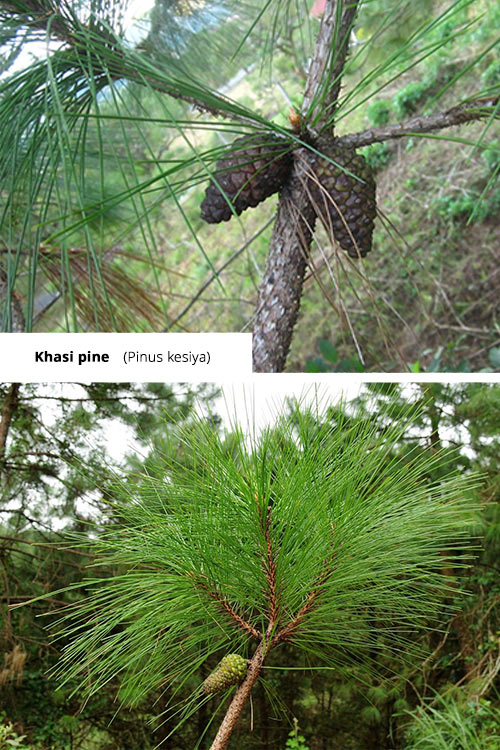
Pinus koraiensis - Korean pine
The Korean pine (Pinus koraiensis) is a medium-sized tree native to Korea, characterized by its dark green needles and large cones. This species is often used for timber and fuel, as well as for decorative purposes.
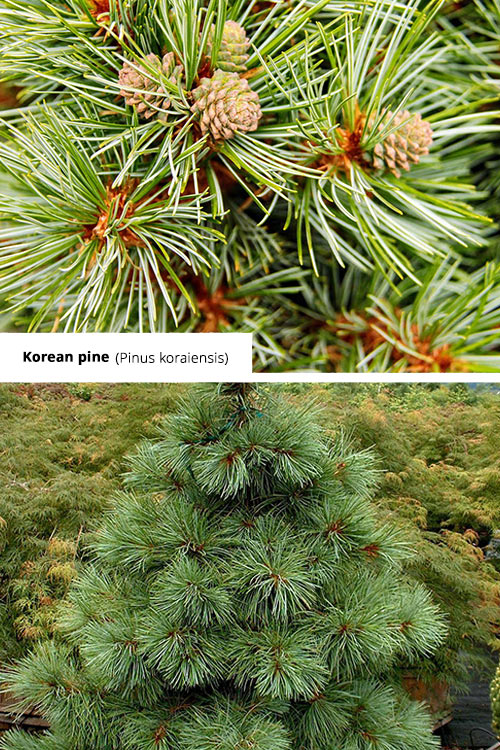
Pinus krempfii - Krempf's pine
The Krempf’s pine (Pinus krempfii) is a rare tree native to Vietnam, characterized by its dark green needles and large cones. This species is often used for timber and fuel, as well as for decorative purposes.
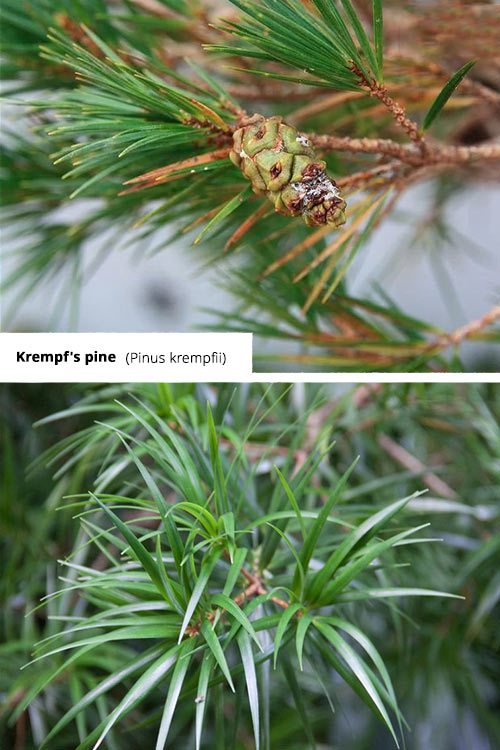
Pinus latteri - Tenasserim pine
The Tenasserim pine (Pinus latteri) is a medium-sized tree native to Southeast Asia, characterized by its dark green needles and large cones. This species is often used for timber and fuel, as well as for decorative purposes.
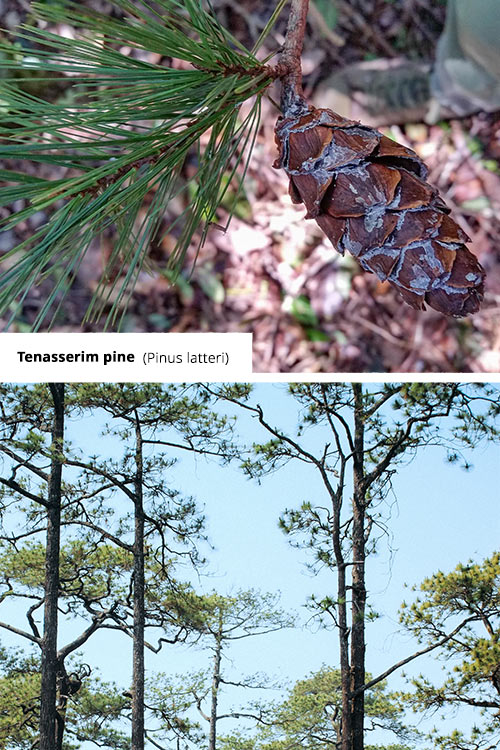
Pinus luchuensis - Luchu pine
The Luchu pine (Pinus luchuensis) is a rare tree native to Okinawa, characterized by its dark green needles and large cones. This species is often used for timber and fuel, as well as for decorative purposes.
It is a valuable resource for the local people, providing them with a sustainable source of income.
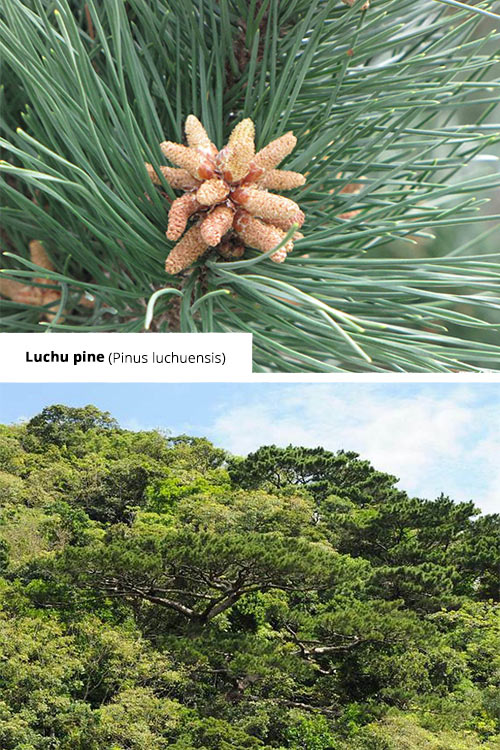
Pinus massoniana - Masson's pine
The Masson’s pine (Pinus massoniana) is a medium-sized tree native to China, characterized by its dark green needles and large cones. This species is often used for timber and fuel, as well as for decorative purposes.
It is a popular choice for landscaping, as it is relatively easy to maintain and can be used for landscaping.
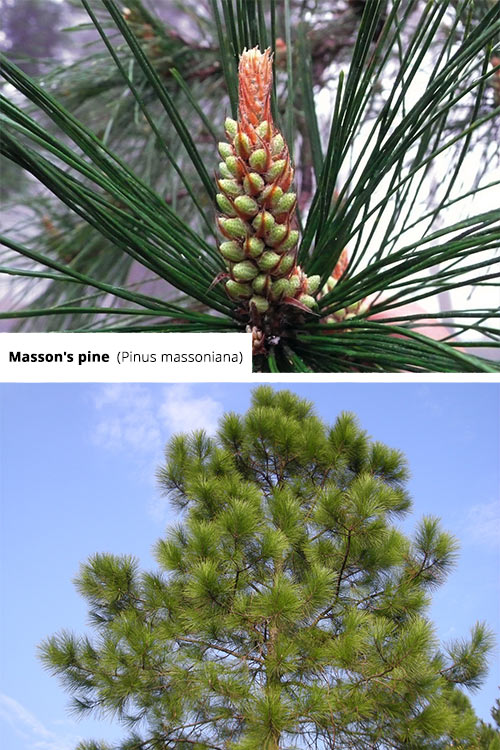
Pinus merkusii - Sumatran pine
The Sumatran pine (Pinus merkusii) is a medium-sized tree native to Indonesia, characterized by its dark green needles and large cones. This species is often used for timber and fuel, as well as for decorative purposes.
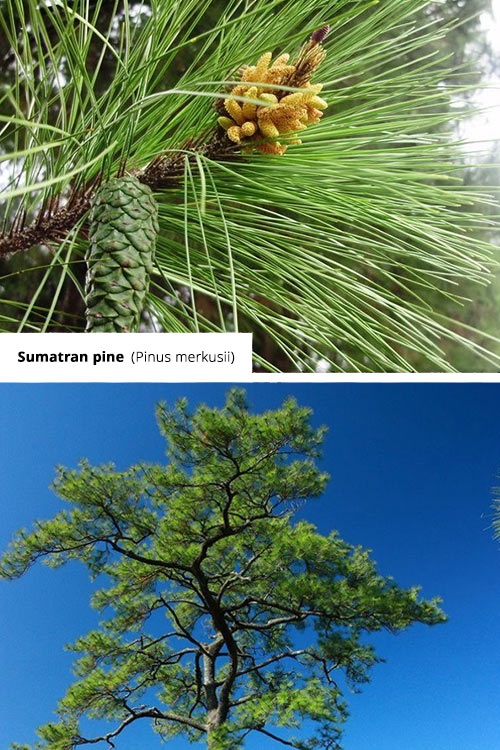
Pinus morrisonicola - Taiwan white pine
The Taiwan white pine (Pinus morrisonicola) is a medium-sized tree native to Taiwan, characterized by its dark green needles and large cones. This species is often used for timber and fuel, as well as for decorative purposes.
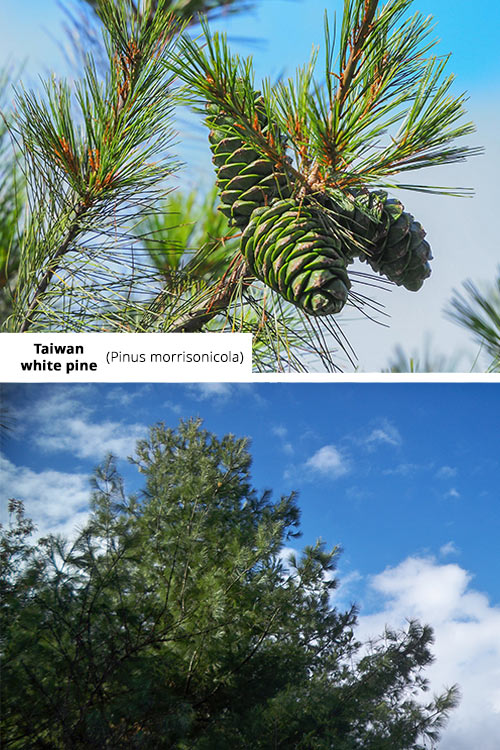
Pinus parviflora - Japanese white pine
The Japanese white pine (Pinus parviflora) is a medium-sized tree native to Japan, characterized by its dark green needles, large cones, and suitability for bonsai.
This species is often used for timber and fuel, as well as for decorative purposes.
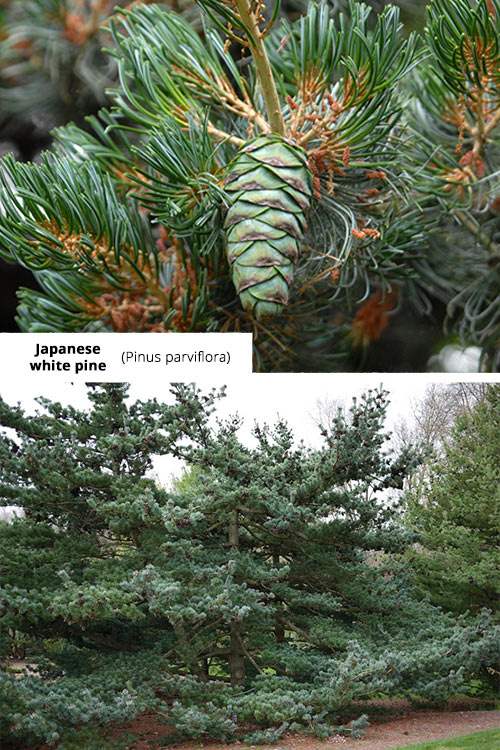
East Asia, Southeast Asia
East Asia and Southeast Asia boast a rich diversity of pine species, each with its own unique characteristics and adaptations. Among the various types of pine trees in the region, some of the most prevalent include:
Pinus pumila - Siberian dwarf pine
The Siberian dwarf pine (Pinus pumila) is a small, shrubby tree native to northeastern Asia. It is characterized by its:
- Slow growth rate
- Adaptability to harsh conditions, such as cold temperatures and poor soils
- Height of 15 to 25 meters
- Three to five needles per fascicle
- Bark that looks like armor, with a grey, plated texture
Despite its modest size, the Siberian dwarf pine plays an essential role in its ecosystem, providing food and shelter for various wildlife species. It is also a valuable source of timber and fuel in the region. This resilient tree serves as a symbol of perseverance and adaptability in the face of adversity.
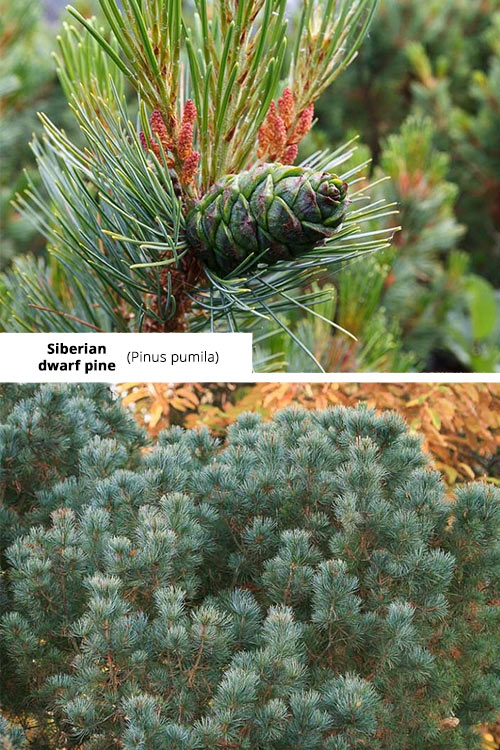
Pinus roxburghii - Chir pine
The Chir pine (Pinus roxburghii) is a large tree native to the Himalayas, where it is often utilized for construction and furniture making. It is easily identifiable by its three needles per bundle and straight trunk. The Chir pine’s timber is known for its strength and durability, making it a valuable resource in the region.
Although not typically used in landscaping, the Chir pine is an essential species for the local ecosystem, providing food and shelter to various wildlife. Its presence also helps prevent soil erosion in the mountainous terrain. The Chir pine is a perfect example of how nature and human needs can harmoniously coexist.
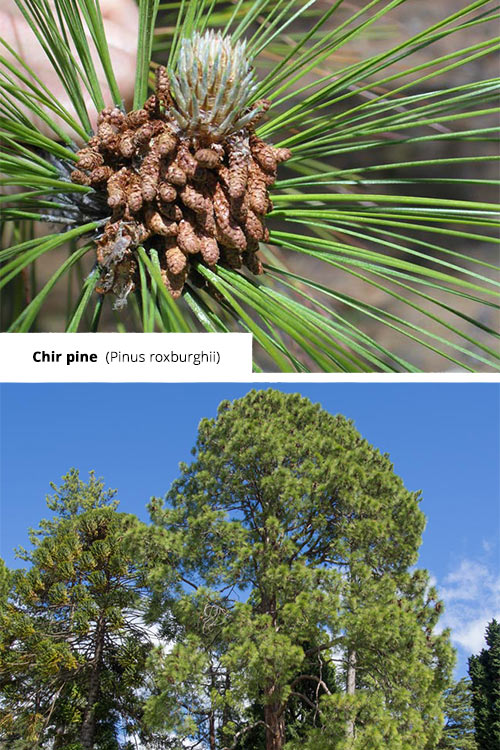
Pinus sibirica - Siberian pine
The Siberian pine (Pinus sibirica) is a cold-hardy tree native to Siberia. It is renowned for its edible seeds and timber value. The tree can reach a height of 30-40 meters, with a trunk diameter of approximately 1.5 meters. It features a straight trunk and numerous spreading branches, resulting in a broadly conical crown.
The Siberian pine’s timber is highly regarded for its strength and suitability for various humidity conditions, making it a popular choice for construction, furniture, and woodworking projects. Additionally, edible seeds are utilized in cooking and baking, adding to the tree’s versatility and value.
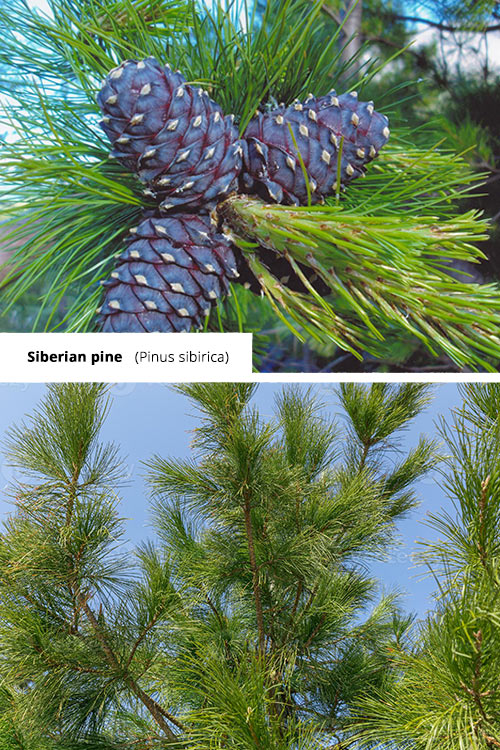
Pinus squamata - Qiaojia pine
The Qiaojia pine (Pinus squamata) is a rare species native to China with limited information available on its characteristics and uses. It is known to be utilized for timber, fuel, and medicinal purposes.
As more research is conducted on this enigmatic species, we may discover new uses and benefits that it can offer.
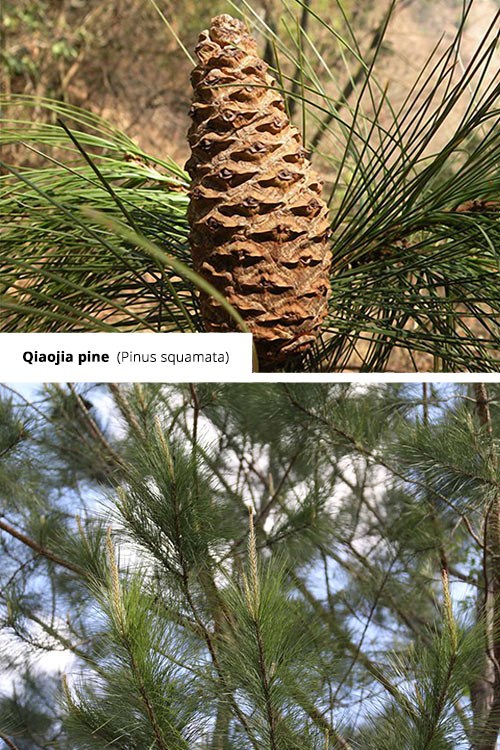
Pinus tabuliformis - Chinese red pine
The Chinese red pine (Pinus tabuliformis) is a medium-sized tree known for its flat-topped crown and grayish-brown bark. It is native to Northern China and Northern Korea, where it is utilized for timber and landscaping purposes. Growing between 30 – 50 feet tall, the Chinese red pine is a popular choice for its timber, which is employed in construction, furniture, and other woodworking projects.
Also known as Manchurian Pine, Chinese Pine, and Southern Chinese Pine, the tree is a versatile species that contributes to the beauty and utility of the landscapes in which it grows. Its unique characteristics make it a valuable resource for both ecological and economic purposes.
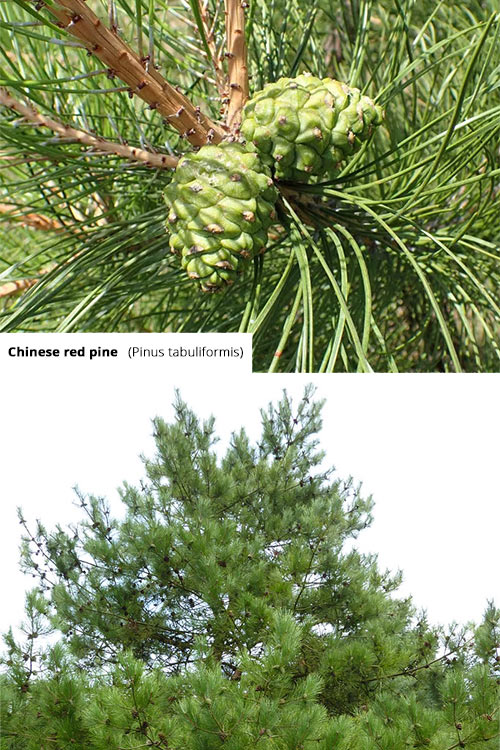
Pinus taiwanensis - Taiwan red pine
Native to Taiwan, the Taiwan red pine (Pinus taiwanensis) is a tall tree with a straight trunk and reddish-brown bark. It is closely related to Pinus luchuensis and is highly regarded for its timber, which is employed in construction, furniture, and other woodworking projects.
In addition to its timber value, the Taiwan red pine is also utilized for decorative purposes, thanks to its attractive appearance and adaptability to various environments. As a testament to its importance, the Taiwan red pine serves as a symbol of strength and beauty in the region.
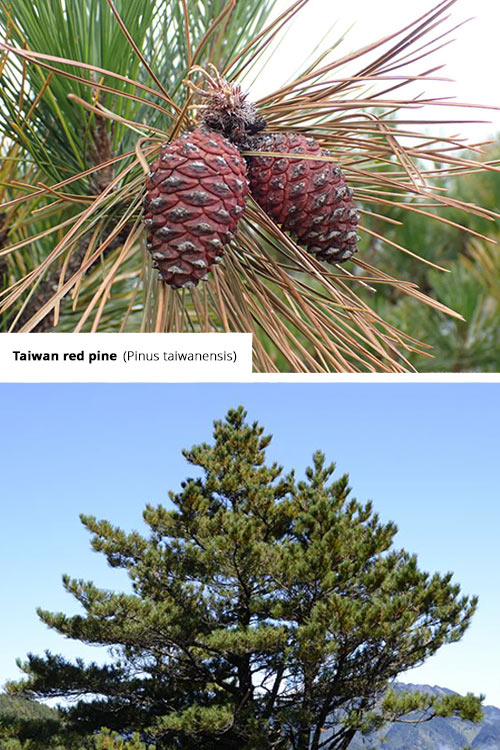
Pinus thunbergii - Japanese black pine
The Japanese black pine (Pinus thunbergii) is a tall tree with a thick trunk and broad crown, native to Japan. Often mistaken for Pitch Pine, this species is known for its straight trunk and reddish-brown bark. The tree is commonly used for timber and landscaping purposes, thanks to its sturdy wood and attractive appearance.
The Japanese black pine’s ability to thrive in various environments, including coastal areas, makes it a popular choice for planting in gardens and parks. Its unique characteristics and versatility make it a valuable resource in both ecological and economic terms.
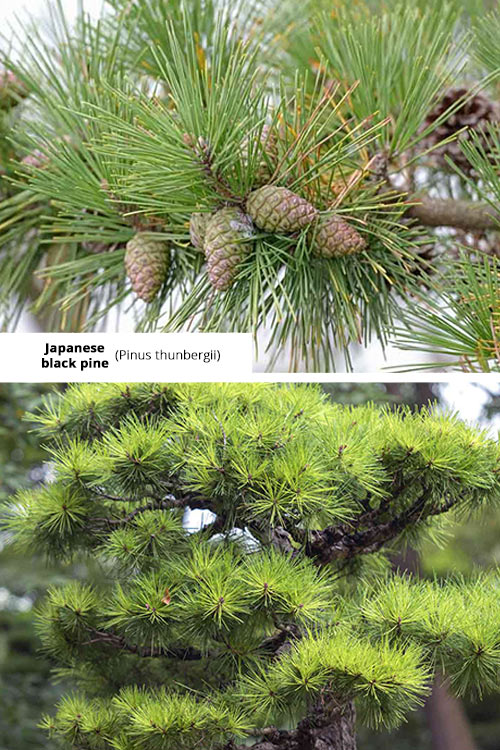
Pinus wallichiana - Blue pine or Bhutan pine
The Blue pine, also known as Bhutan pine (Pinus wallichiana), is a tall tree characterized by its blue-green needles and a distinctive bluish tint to its bark. Native to South Asia, this species is often utilized for timber and landscaping purposes.
The striking appearance of the Blue pine makes it a popular choice for planting in gardens and parks, adding a touch of elegance and color to the landscape. Its timber is also highly valued for its strength and durability, making it a versatile and useful resource.
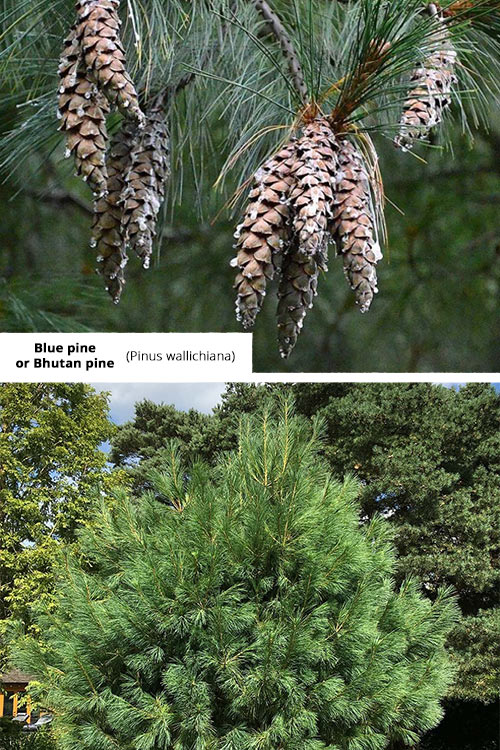
Pinus wangii (syn. P. kwangtungensis) - Guangdong white pine
The Guangdong white pine (Pinus wangii, synonym: P. kwangtungensis) is a rare species of pine tree native to China. Limited information is available on its characteristics and uses, but it is known to be utilized for timber, fuel, and ornamental purposes.
As more research is conducted on this little-known species, we may uncover new benefits and applications it can offer.
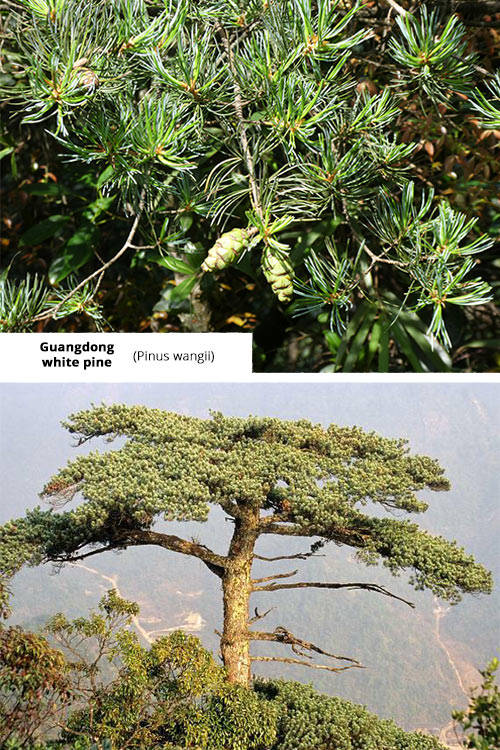
Pinus yunnanensis - Yunnan pine
The Yunnan pine (Pinus yunnanensis) is a tall tree native to China, known for its straight trunk and reddish-brown bark. It is widely utilized for its timber, which is employed in construction, furniture, and other woodworking projects. The tree’s attractive appearance also makes it popular for landscaping purposes.
Thriving primarily in the People’s Republic of China, the Yunnan pine serves as a valuable resource for both ecological and economic purposes. Its unique characteristics and versatility make it an essential species in the region.
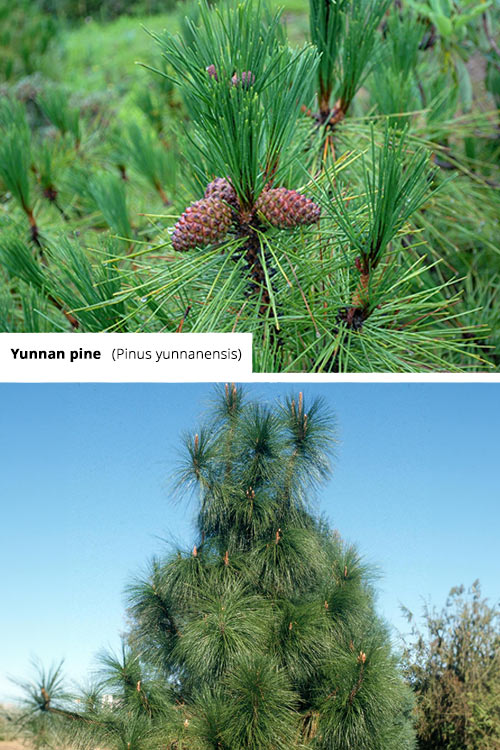
Eastern Canada, Eastern United States
The Eastern Canada and Eastern United States regions are home to a diverse array of pine tree species, each with its own unique characteristics and uses. Some of the most prevalent species in these areas include:
Pinus banksiana - Jack pine
The Jack pine (Pinus banksiana) is a fast-growing tree native to eastern North America. It is characterized by its short needles that grow in clusters of two, a conical crown, and egg-shaped cones. This species is particularly resilient, with a unique needle-shedding pattern that allows it to be restored quickly after forest fires.
The Jack pine’s fast growth rate and adaptability make it a valuable resource for timber and landscaping purposes. Its unique characteristics also serve as a testament to the incredible diversity of pine trees found in the eastern regions of North America.
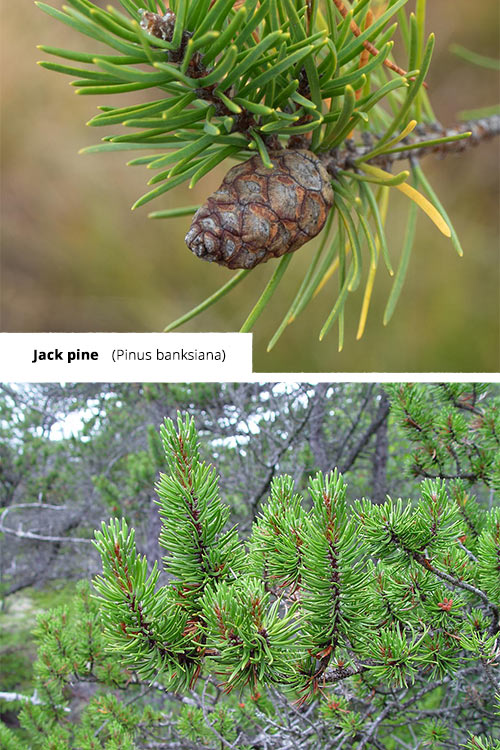
Pinus clausa - Sand pine
The Sand pine (Pinus clausa) is a small tree characterized by a straight or leaning trunk, a heavily branched rounded crown, and small seed cones, native to the southeastern United States. The twisted, branching habit, combined with its slender needles and serrated margins, makes it easy to distinguish from other species of pine. Additionally, reddish-brown seed-bearing cones add to their unique characteristics.
Thriving primarily in sandy soils, the Sand pine is a valuable resource for both ecological and economic purposes. Its unique characteristics and adaptability make it an essential species in the southeastern regions of the United States.
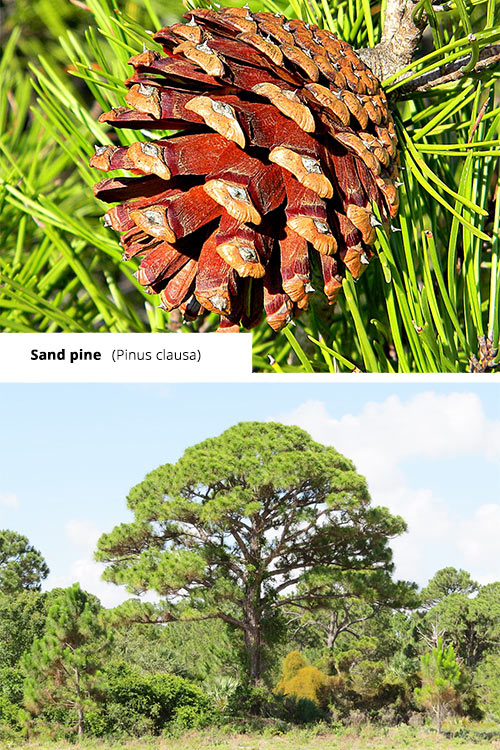
Pinus echinata - Shortleaf pine
The Shortleaf pine (Pinus echinata) is a medium-sized tree native to the southeastern United States. It is known for its:
- Red-brown, scaly-plated bark
- Gray-green to yellow-green leaves
- Shorter needles
- Smaller cones
It is often mistaken for the Longleaf pine, but these characteristics set it apart.
Shortleaf pine is a versatile species, used for both timber and landscaping purposes. Its unique characteristics and adaptability make it a valuable resource in the southeastern regions of the United States.
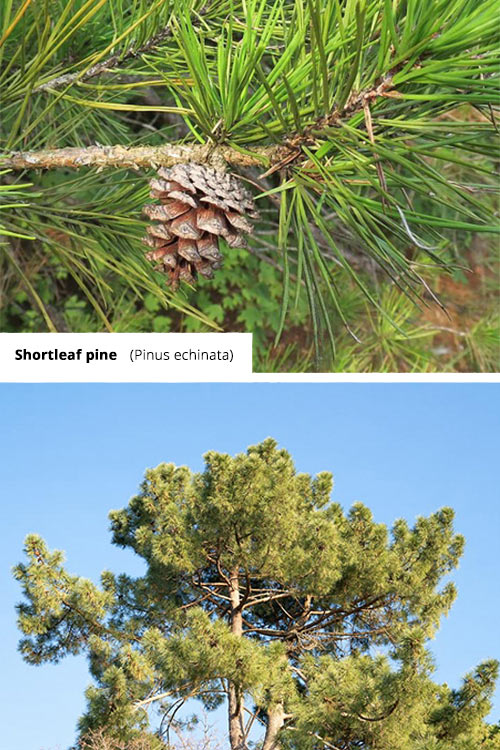
Pinus elliottii - Slash pine
The Slash pine (Pinus elliottii) is an evergreen tree that grows in the southern United States, requiring fire protection to maintain its habitat. It is characterized by needles that grow in clusters of three, a conical crown, and egg-shaped cones. The tree is commonly used for timber and landscaping purposes, thanks to its sturdy wood and attractive appearance.
As a testament to its importance, the Slash pine serves as a symbol of strength and beauty in the region. Its unique characteristics and versatility make it a valuable resource in both ecological and economic terms.
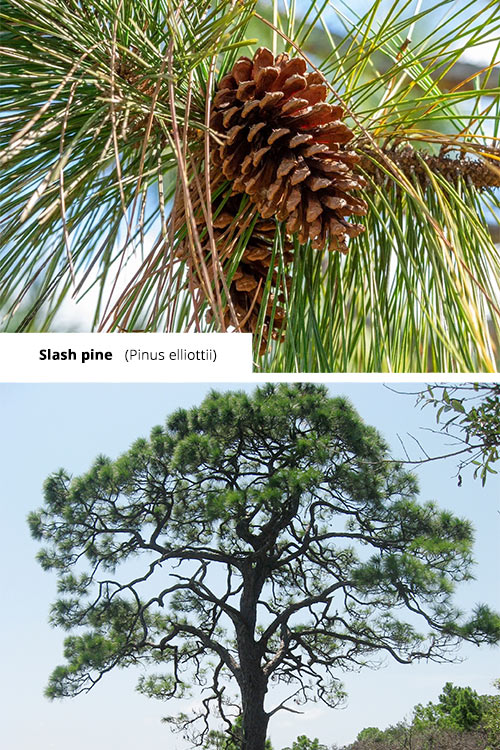
Pinus glabra - Spruce pine
The Spruce pine (Pinus glabra), not to be confused with the sugar pine, is a small to medium-sized tree with the following characteristics:
- Straight trunk
- Conical crown
- Smooth, gray bark
- Dark green needles
It is native to the southeastern United States and is easily distinguishable from other pine species.
Thriving primarily in wet soils, the Spruce pine is a valuable resource for both ecological and economic purposes. Its unique characteristics and adaptability make it an essential species in the southeastern regions of the United States.
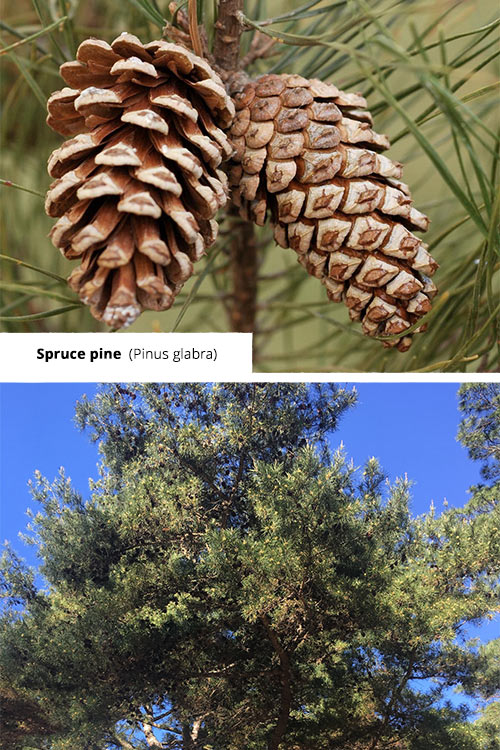
Pinus palustris - Longleaf pine
The Longleaf pine (Pinus palustris) is a tall tree with the following characteristics:
- Long needles
- Needles that grow in clusters of three
- A conical crown
- Egg-shaped cones
This tree is native to the southeastern United States and has historically been used for ship construction. It requires regular fires to thrive.
Today, the Longleaf pine serves as a valuable resource for timber and landscaping purposes. Its unique characteristics and historical significance make it a vital part of the region’s ecology, economy, and culture.
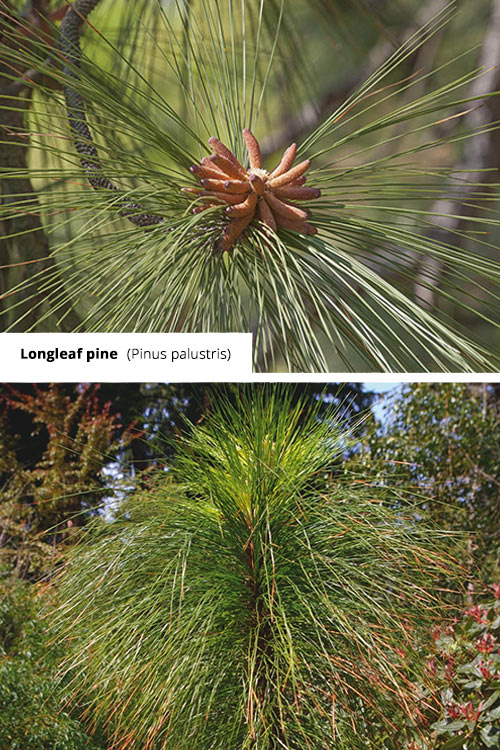
Pinus pungens - Table Mountain pine
The Table Mountain pine (Pinus pungens) is a medium-sized tree with the following characteristics:
- Straight trunk
- Rounded crown
- Deeply grooved red-brown bark
- Stiff yellow-green leaves
It is native to the Appalachian Mountains and is easily distinguishable from other pine species.
The Table Mountain pine is a valuable resource for both ecological and economic purposes, as its timber is highly regarded for its strength and durability. Its unique characteristics and adaptability make it an essential species in the Appalachian Mountains.
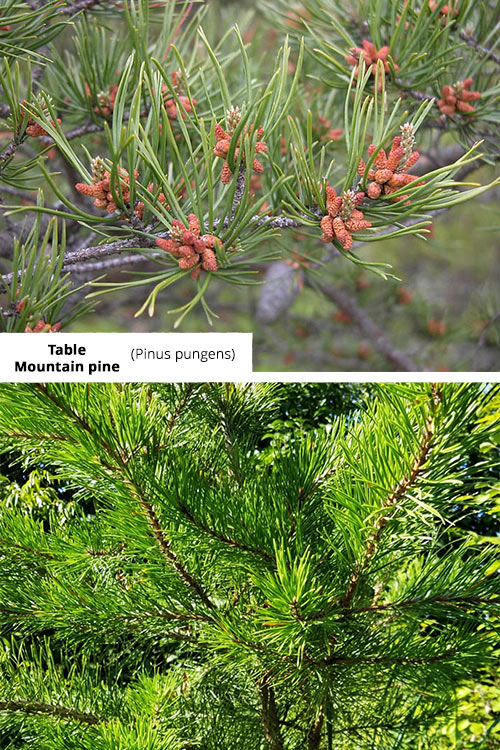
Pinus resinosa - Red pine
The Red pine, also known as Norway pine, has the following characteristics:
- Pale redwood
- Two needles per bundle
- Conical crown
- Egg-shaped cones
This species is native to eastern North America and is commonly used for timber and landscaping purposes.
The Red pine’s unique characteristics and versatility make it a valuable resource in both ecological and economic terms. Its strength and durability make it an ideal choice for construction, furniture, and other woodworking projects.
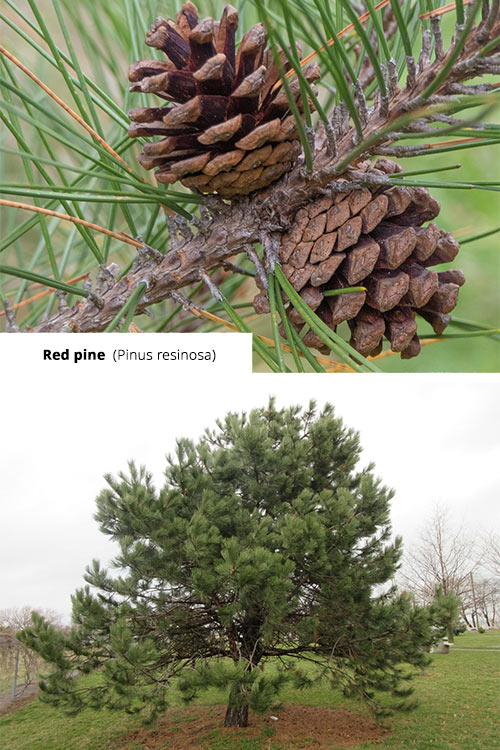
Pinus rigida - Pitch pine
The Pitch pine (Pinus rigida) is a medium to large-sized tree with the following characteristics:
- Deeply grooved red-brown bark
- Stiff yellow-green leaves
- Needles that grow in clusters of three
- Bark that eventually becomes black
It is native to the eastern United States.
The pitch pine is a versatile species, used for both timber and landscaping purposes. Its unique characteristics and adaptability make it a valuable resource in the eastern regions of the United States.
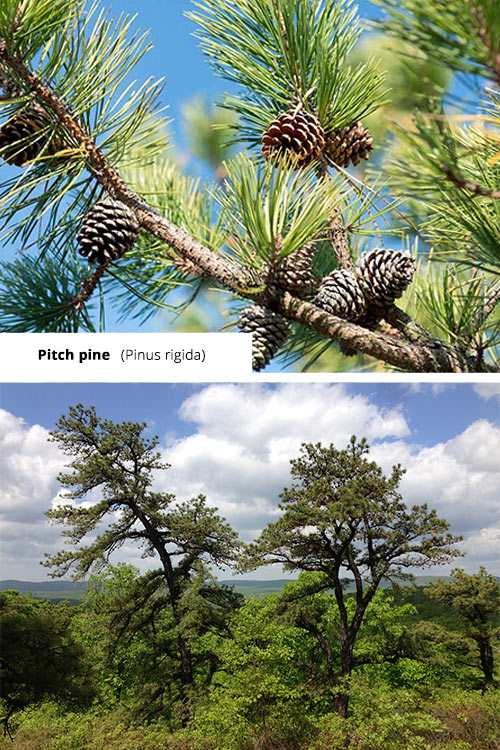
Pinus serotina - Pond pine
Pond pine (Pinus serotina) is a stunted tree that grows in wet soils, identifiable by its yellow-green thick leaves and red-brown bark. It is native to the southeastern United States, where it thrives in swampy habitats and is commonly observed as the overstory tree in these environments.
Pond pine is a valuable resource for both ecological and economic purposes, as its timber is highly regarded for its strength and durability. Its unique characteristics and adaptability make it an essential species in the southeastern regions of the United States.
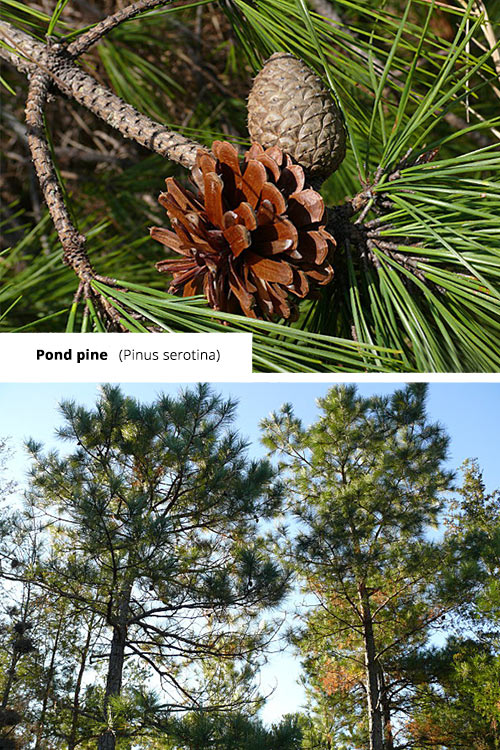
Pinus strobus - Eastern white pine
The Eastern white pine (Pinus strobus) is a tall tree with a straight trunk and a conical crown, native to eastern North America. It is characterized by its long needles that grow in clusters of five and its light-hued bark. This species is commonly used for timber and landscaping purposes, thanks to its sturdy wood and attractive appearance.
The Eastern white pine’s unique characteristics and versatility make it a valuable resource in both ecological and economic terms. Its strength and durability make it an ideal choice for construction, furniture, and other woodworking projects.
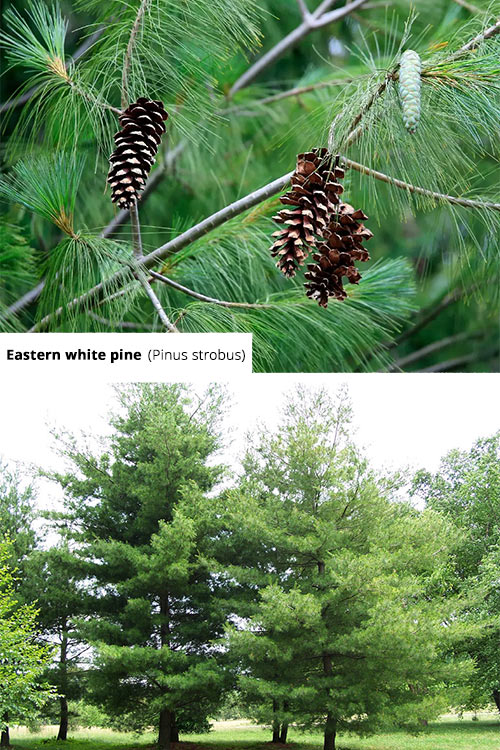
Pinus taeda - Loblolly pine
The Loblolly pine (Pinus taeda) is a tall tree with red-brown bark and deep yellow-green leaves, native to the southeastern United States. It is commonly used for timber and landscaping purposes, thanks to its sturdy wood and attractive appearance.
The Loblolly pine is a versatile species that contributes significantly to the region’s ecology, economy, and culture. Its unique characteristics and adaptability make it a valuable resource in the southeastern regions of the United States.
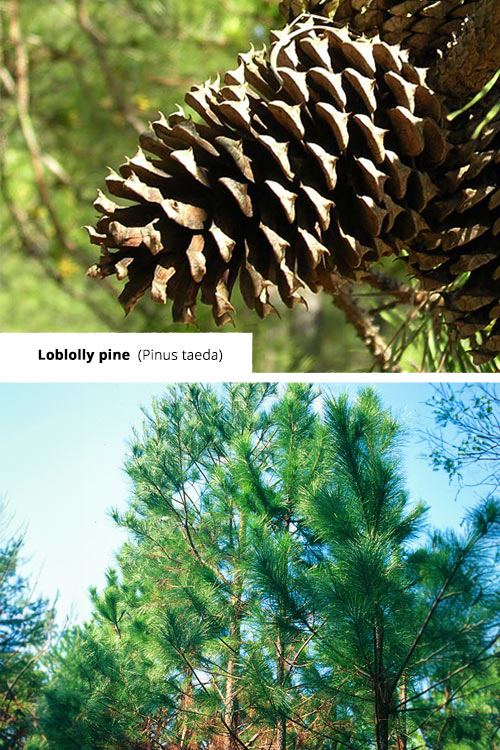
Pinus virginiana - Virginia pine
The Virginia pine (Pinus virginiana) is a small to medium-sized tree with the following characteristics:
- Straight, contorted, or leaning trunk
- Irregularly rounded or flattened crown
- Native to the eastern United States
- Thin, flexible pine needles with twisted tufts at the tips
- Needles grow 5” to 6.5” (12 – 16 cm) long in bundles of three.
The Virginia pine is a valuable resource for both ecological and economic purposes, as its timber is highly regarded for its strength and durability. Its unique characteristics and adaptability make it an essential species in the eastern regions of the United States.
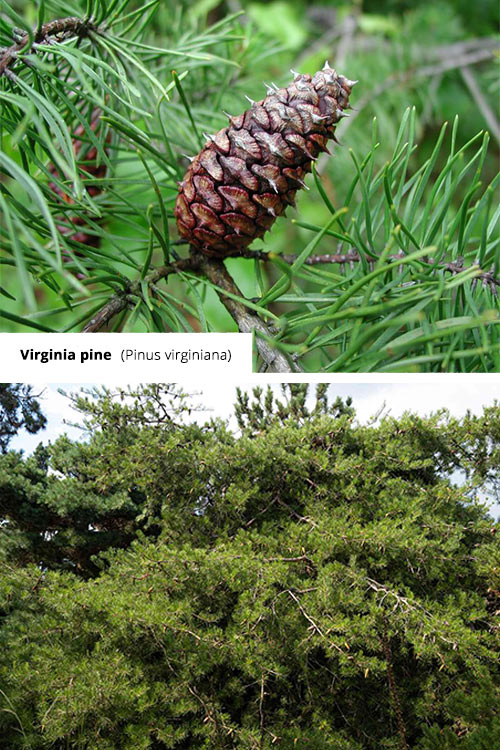
Western Canada, Western United States, Northern Mexico
The Western Canada, Western United States, and Northern Mexico regions are home to a diverse array of pine tree species, each with its own unique characteristics and uses. Some of the most prevalent species in these areas include:
- Whitebark pine
- Rocky Mountains bristlecone pine
- Knobcone pine
- Foxtail pine
- Lodgepole pine
These species contribute significantly to the region’s ecology, economy, and culture. They provide food and shelter for wildlife, timber for construction and furniture, and a source of employment.
Pinus albicaulis - Whitebark pine
The Whitebark pine (Pinus albicaulis) is a scrubby tree that thrives at high elevations, often found in subalpine forests. It is native to the western United States and is rarely used in landscape planting due to its preference for harsh, high-altitude environments. The tree’s unique characteristics make it an essential species for maintaining the ecosystems in which it grows.
Despite its limited use in landscaping, the Whitebark pine serves as a valuable resource for both ecological and economic purposes. Its unique characteristics and adaptability make it an essential species in the western regions of North America.
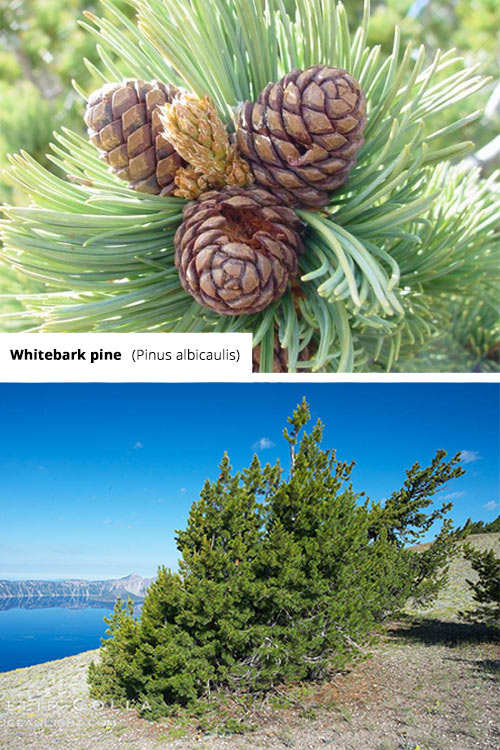
Pinus aristata - Rocky Mountains bristlecone pine
The Rocky Mountains bristlecone pine (Pinus aristata) is a slow-growing tree native to the Rocky Mountains. It is characterized by twisted, tapering trunks and short, upcurved leaves, making it easily distinguishable from other pine species, such as the ponderosa pine tree. The tree is often found in high-altitude environments, making it a symbol of resilience and adaptability.
The Rocky Mountains bristlecone pine serves as a valuable resource for both ecological and economic purposes. Its unique characteristics and adaptability make it an essential species in the western regions of North America.
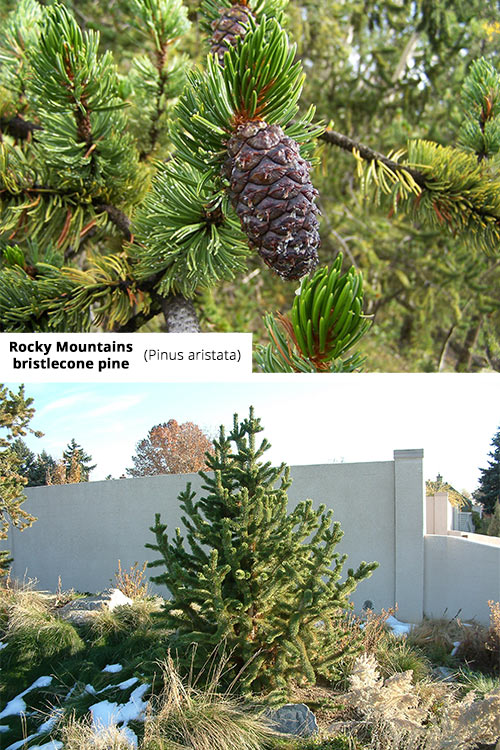
Pinus attenuata - Knobcone pine
The Knobcone pine (Pinus attenuata) is a medium-sized tree with the following characteristics:
- Straight trunk
- Rounded crown
- Needles measuring 1” (2.5 cm) in length, the shortest of any pine species
- Bark of a reddish or cinnamon hue
It is native to the western United States.
The Knobcone pine is a versatile species that contributes significantly to the region’s ecology, economy, and culture. Its unique characteristics and adaptability make it a valuable resource in the western regions of the United States.
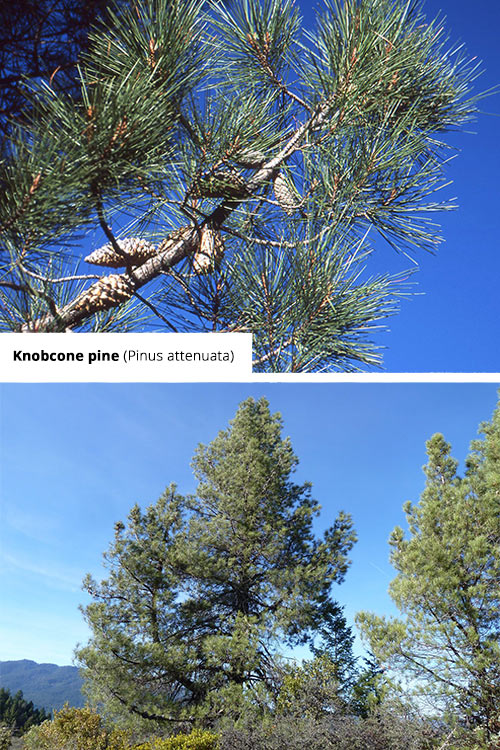
Pinus balfouriana - Foxtail pine
The Foxtail pine (Pinus balfouriana) is a small to medium-sized tree with a straight trunk and a conical crown, native to the western United States. It is characterized by needles measuring 1” (2.5 cm) in length, the shortest of any pine species, and its bark is of a reddish or cinnamon hue.
The Foxtail pine is a versatile species that contributes significantly to the region’s ecology, economy, and culture. Its unique characteristics and adaptability make it a valuable resource in the western regions of the United States.
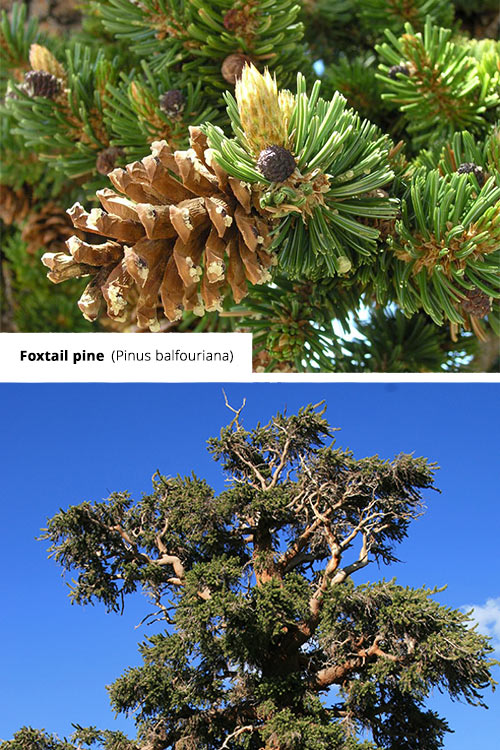
Pinus contorta - Lodgepole pine
The Lodgepole pine (Pinus contorta) is a tall tree with the following characteristics:
- Straight trunk
- Conical crown
- Needles that grow in clusters of two
- Egg-shaped cones
This species is native to western North America and is commonly used for timber and landscaping purposes, thanks to its sturdy wood and attractive appearance.
The Lodgepole pine’s unique characteristics and versatility make it a valuable resource in both ecological and economic terms. Its strength and durability make it an ideal choice for construction, furniture, and other woodworking projects.
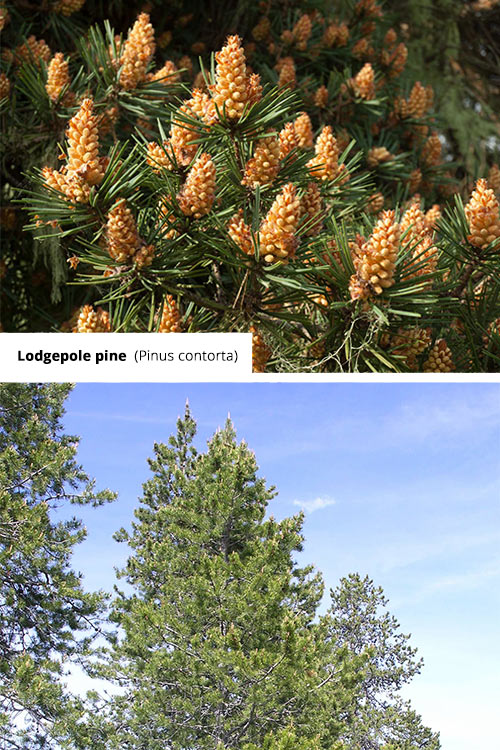
Pinus coulteri - Coulter pine
The Coulter Pine (Pinus coulteri) is a large, hard pine native to California and Mexico, known for its massive cones and long needles, similar to the longleaf pine. It has the capability of growing up to a height of 33 feet. Similarly, it can even reach 66 ft. (10 – 20m) and is often found on the coastal mountains of California, extending into Mexico.
The tree’s pine tree needles grow in bundles of three, a distinct feature that sets it apart from species like the Jack Pine, which has two needles per bundle. These majestic trees not only provide a striking addition to any landscape but also serve as a testament to the incredible diversity of pine trees.
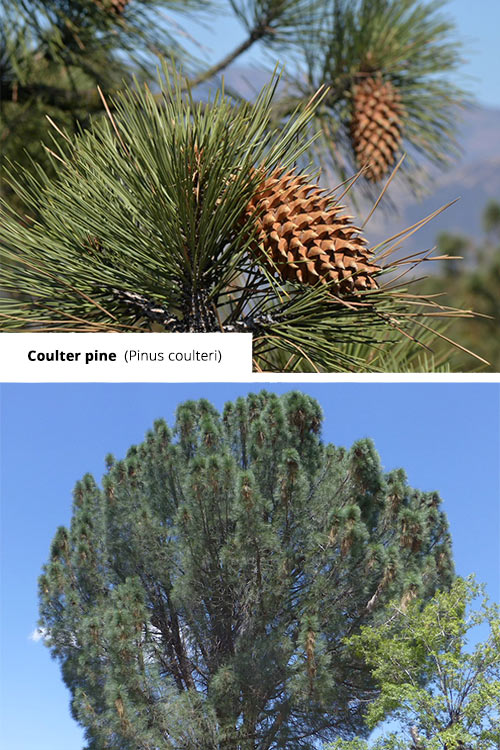
Pinus edulis - Colorado pinyon
The Colorado Pinyon (Pinus edulis) is a small, drought-tolerant pine native to the southwestern United States, producing edible pine nuts. Found primarily in zones 5 to 8, this resilient tree can grow between 33 and 66 feet (10 – 20m) tall and thrive in a variety of soils, even highly acidic ones, as long as they are well-drained.
With its blue-green hue foliage and egg-shaped cones, the Pinyon Pine stands out among other pine species not only for its unique appearance but also for its delectable, edible nuts.
The Pinyon Pine is a wonderful example of how pine trees have adapted to flourish in diverse environments and offer valuable resources.
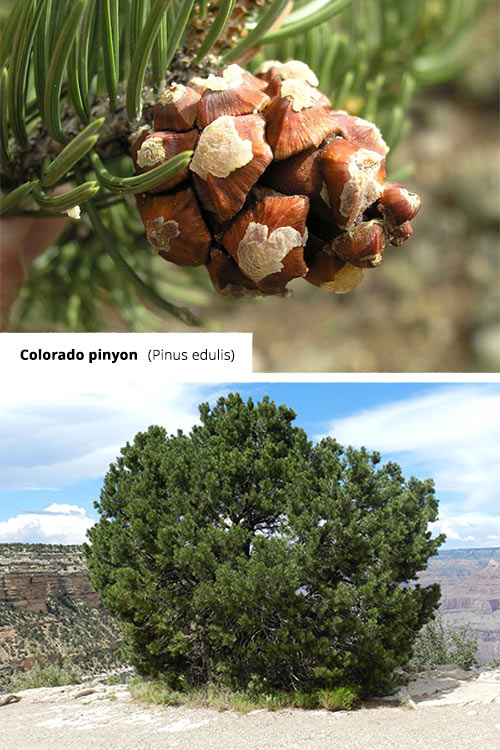
Pinus flexilis - Limber pine
The Limber Pine (Pinus Flexilis) is a medium-sized pine found in western North America. It is known for its:
- Flexible branches
- Ability to grow in harsh conditions
- Smooth, light-gray bark
- Long, five-needled fascicles
The Limber Pine is both an attractive and resilient tree species, similar to the Loblolly Pine in its adaptability.
It can be found in the mountains of Southwest Canada, extending through California and Arizona, where it endures cold, dry climates and rocky soils. The Limber Pine’s adaptability and striking appearance make it a fascinating addition to the world of pine trees.
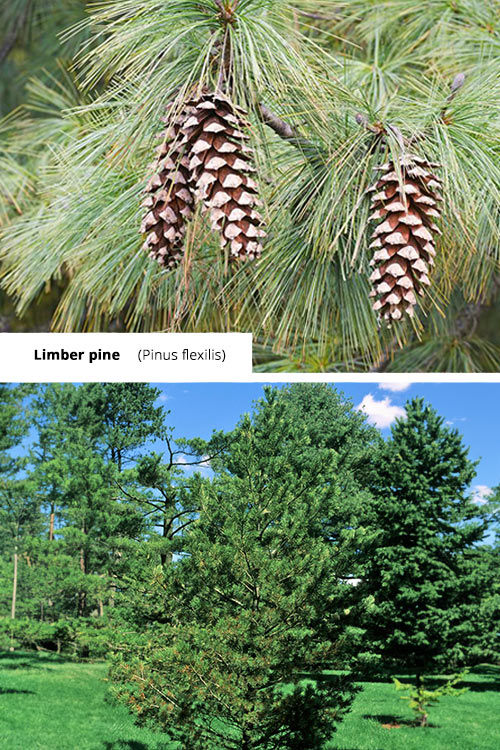
Pinus jeffreyi - Jeffrey pine
Standing tall in the forests of western North America, the Jeffrey Pine (Pinus jeffreyi) is a hard pine known for its long needles, large cones, and fragrant bark with a distinct aroma reminiscent of vanilla or butterscotch. This attractive tree can grow up to 235 feet (72 m) in height and boasts three needles per bundle, a unique characteristic among pine species, including the Virginia Pine.
Often used for lumber, the Jeffrey Pine is not only a vital resource but also a captivating presence in the diverse world of pine trees.
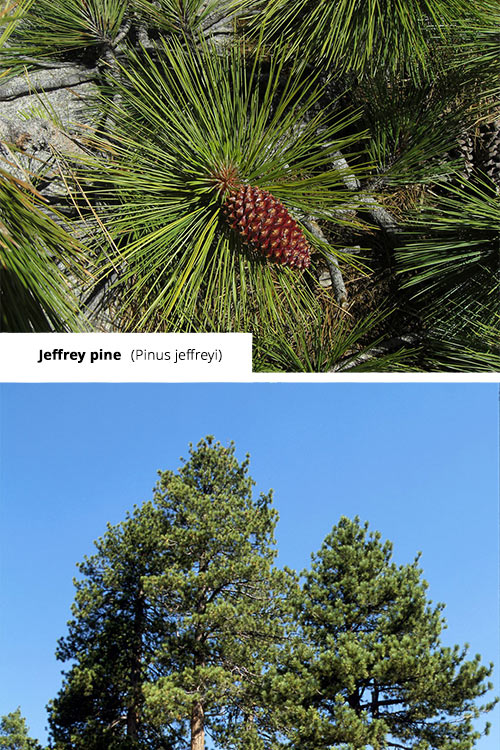
Pinus lambertiana - Sugar pine
The Sugar Pine (Pinus lambertiana) proudly holds the title of the tallest and most massive pine tree, native to the western United States. Its needles grow in bundles of five and can reach up to 20 inches long, while its cones can grow even larger, weighing over 4 pounds each.
Renowned for its sweet resin, the Sugar Pine is an awe-inspiring example of the incredible heights pine trees can reach both literally and figuratively.
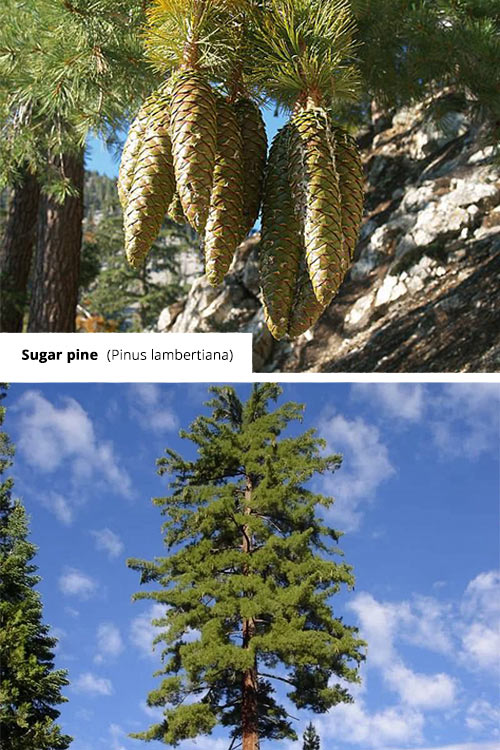
Pinus longaeva - Great Basin bristlecone pine
The Great Basin Bristlecone Pine (Pinus longaeva) is one of the oldest living tree species, found in the high mountains of the western United States. Characterized by its showy gray to reddish-brown bark and five-needled fascicles, its cones are small yet prickly and egg-shaped when ripe.
With its ability to grow in cold, dry climates at elevations of up to 10,200 feet, the Bristlecone Pine is a testament to the resilience and longevity of these ancient trees.
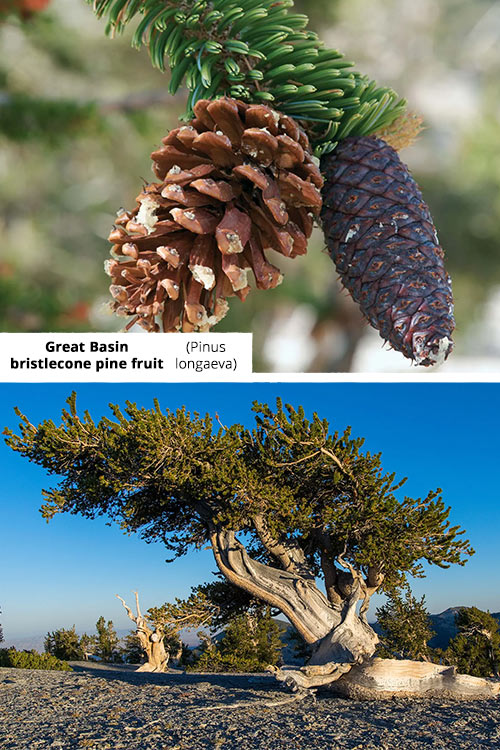
Pinus monophylla - Single-leaf pinyon
The Single-leaf Pinyon (Pinus monophylla) is a unique pine species native to the southwestern United States, with the following characteristics:
- Single needles
- Edible pine nuts
- Small, drought-tolerant tree
- Thick, scaly bark
- Slender, dull-gray needle leaves
Its globular cones and ability to grow in arid, rocky slopes and canyons make the Single-leaf Pinyon a fascinating addition to the diverse world of pine trees.
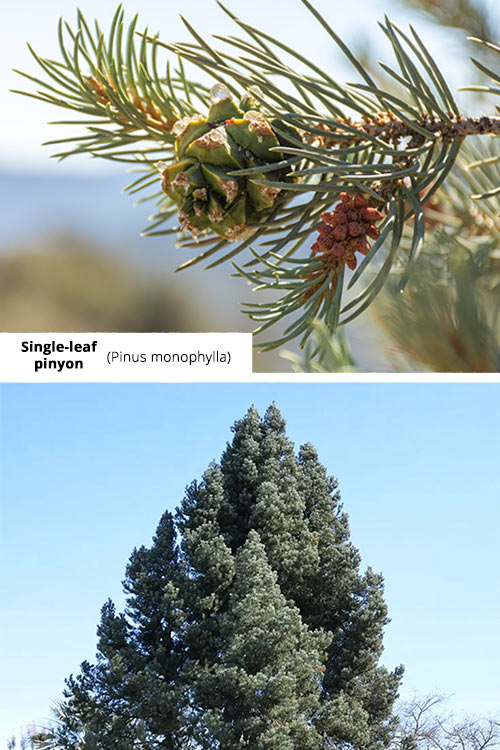
Pinus monticola - Western white pine
The Western White Pine (Pinus monticola), one of the majestic white pine trees, is a tall, soft pine native to the western United States, with the following characteristics:
- Blue-green needles
- Large cones
- Silvery-green leaves that grow in groups of five
- Can reach impressive heights of 130 to 195 feet
This tree is often used for lumber due to its desirable qualities.
As both a valuable resource and a stunning presence in the landscape, the Western White Pine is an essential member of the pine tree family.
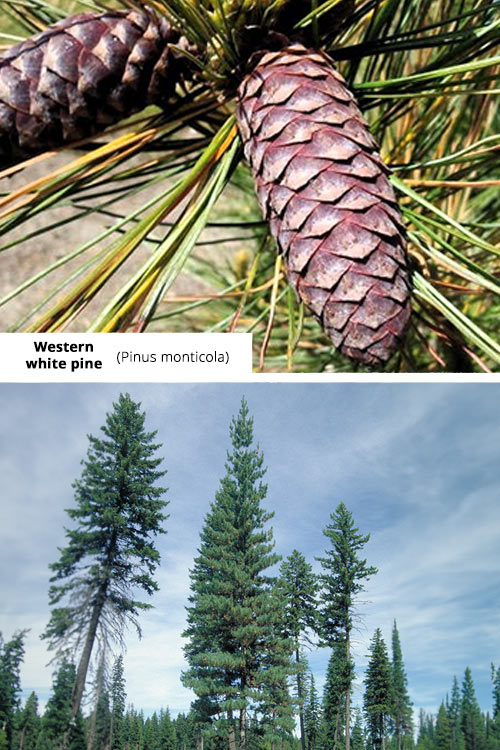
Pinus muricata - Bishop pine
The Bishop Pine (Pinus muricata), a relative of the pitch pine and pond pine, is a medium-sized, hard pine native to the western United States. It is characterized by its:
- Short needles
- Small cones
- Rounded pine cones
- Pale grayish-green needles in fascicles of three
- Sparse leaf growth
The Bishop Pine thrives in the northern portion of Inverness Ridge and coastal regions, similar to the Scots pine.
The Bishop Pine is an intriguing species that adds to the rich variety of pine trees found across the globe.
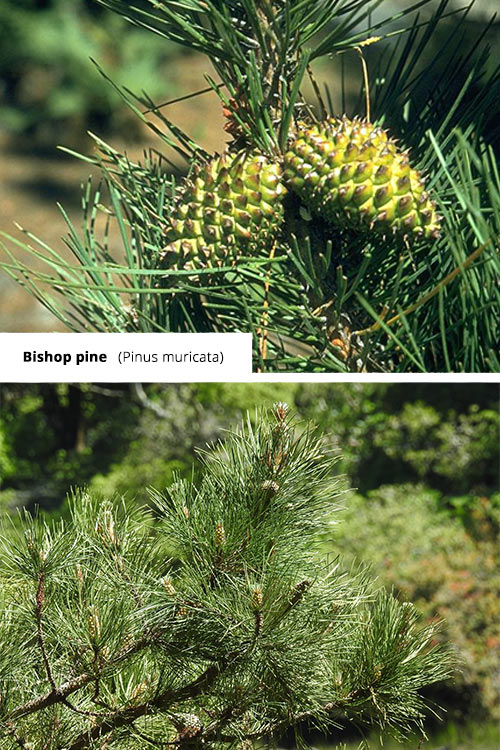
Pinus ponderosa (syn. P. washoensis) - Ponderosa pine
The Ponderosa Pine (Pinus ponderosa) is a tall, hard pine native to western North America, boasting long needles and large cones, often used for lumber and landscaping. With its dark purple to red-brown cones measuring between 2” to 4” (5 – 10 cm) in length, the ponderosa pine tree is an iconic symbol of the great outdoors and the incredible diversity of pine trees.
Its coarse, gray bark and large cones make it a popular choice for both timber production and ornamental landscaping.
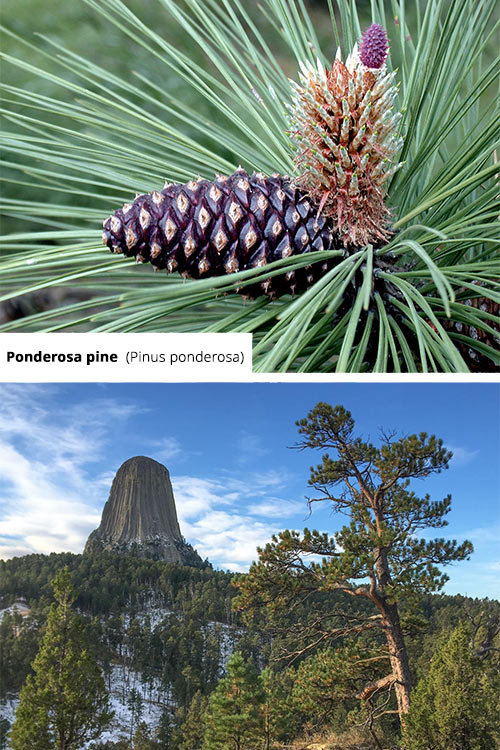
Pinus radiata - Monterey pine, radiata pine
The Monterey Pine (Pinus radiata) is a medium-sized, soft pine native to California and Mexico, with long needles and large cones, often used for timber and reforestation. Known for its pale green needles growing in bundles of three and its long, slender, pale brown, smooth cones, the Monterey Pine is both a valuable resource and a beautiful addition to the landscape.
Its versatility and unique appearance make it a captivating member of the pine tree family.
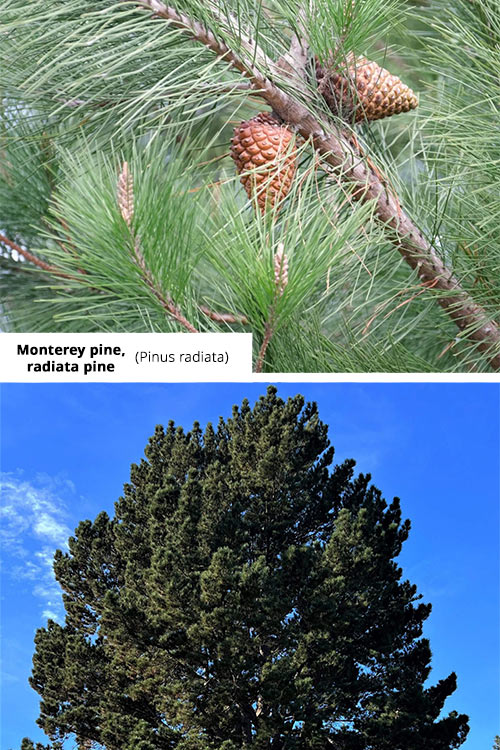
Pinus remota - Texas pinyon, papershell pinyon
The Texas Pinyon (Pinus remota) is a small, drought-tolerant pine native to Texas and Mexico, with the following characteristics:
- Short needles
- Small cones
- Edible pine nuts
- Thick, scaly bark
- Slender, dull-gray needle leaves
- Globular cones
These unique features make it a distinctive addition to the diverse world of pine trees.
Found in the mountains and high deserts of Texas, New Mexico, and Arizona, the Texas Pinyon is a remarkable example of the adaptability and resilience of pine trees.
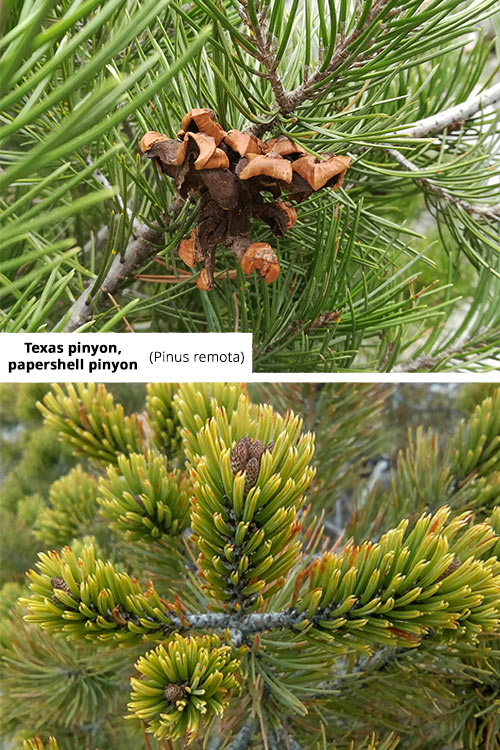
Pinus sabineana - Gray pine, foothill pine, digger pine
The Gray Pine (Pinus sabiniana) is a medium-sized, hard pine native to California, with grayish bark and long needles, often used for lumber and landscaping. Its rounded, open-to-dense crown, dark gray bark, and long needles make it a striking addition to any landscape.
With its heavy, barrel-like cones weighing up to 1.5 lbs. (0.7 kg), the Gray Pine is a fascinating species that adds to the rich diversity of pine trees.
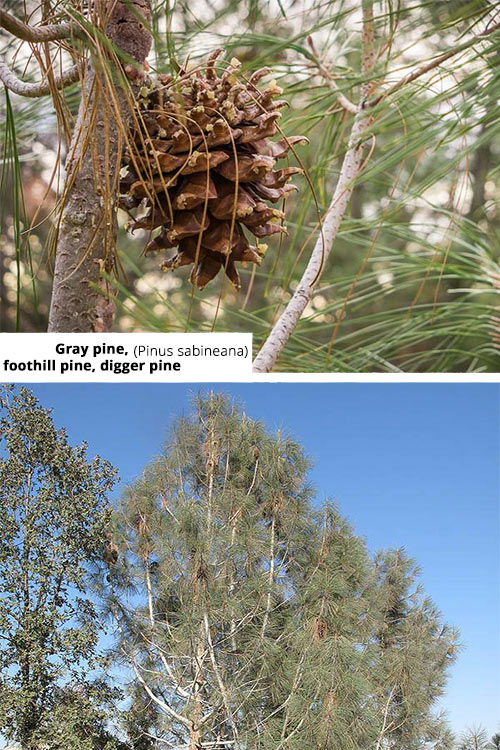
Pinus strobiformis - Southwestern white pine
The Southwestern White Pine (Pinus strobiformis) is a medium-sized, soft pine native to the southwestern United States, with blue-green needles and small cones. Found in the Rocky Mountains of Colorado and extending down into Northern New Mexico, this tree’s long needles and small cones make it an interesting species among the diverse world of pine trees.
With its unique appearance and ability to grow in various climates, the Southwestern White Pine is truly a captivating addition to the pine tree family.
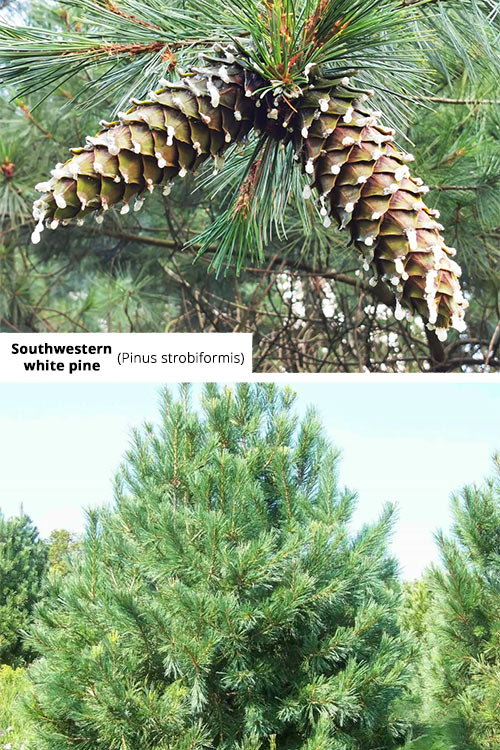
Pinus torreyana - Torrey pine
The Torrey Pine (Pinus torreyana) is a rare, endangered pine native to coastal California, known for its twisted branches and small cones. As the rarest native pine tree found in the United States, the Torrey Pine is a testament to the incredible diversity and adaptability of these majestic evergreens.
Its unique twisted appearance and status as an endangered species make it a fascinating and important member of the pine tree family.
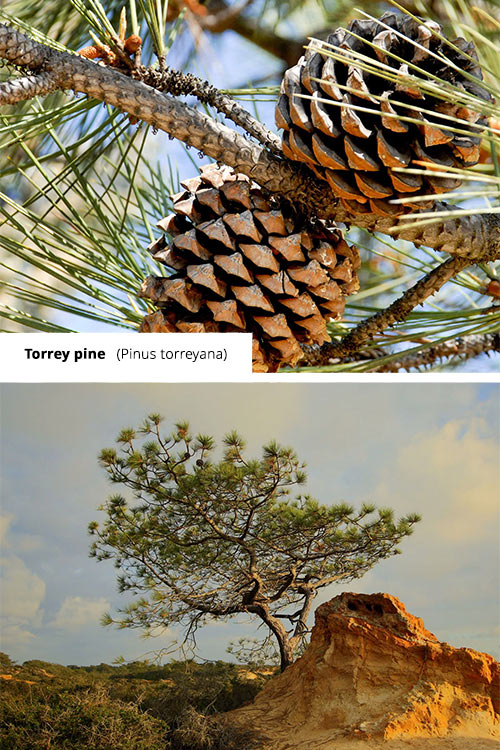
Southwestern United States, Mexico, Central America, Caribbean
Pinus arizonica - Arizona pine
The Arizona Pine (Pinus arizonica) is a species of pine tree indigenous to Arizona, characterized by its needle-like leaves bundled in clusters, with 1-7 needles per fascicle. Its seeds are utilized as a food source, particularly in the preparation of pesto sauce.
Now, let’s explore various pine species found in different regions, from Mexico and Central America to the Caribbean, each with its distinctive characteristics and uses.
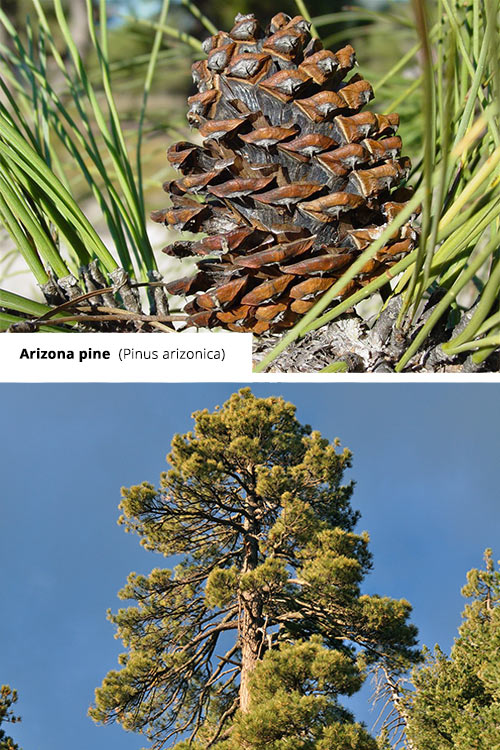
Pinus ayacahuite - Mexican white pine
The Mexican White Pine (Pinus ayacahuite) is a tall, soft pine native to Mexico and Central America, with the following characteristics:
- Long needles
- Large cones
- Rapid growth rate
- Maximum height of 65-100 feet
The Mexican White Pine, also known as the Mexican Weeping Pine Tree, is an impressive tree species that is often used for timber and reforestation.
Its unique characteristics and ability to thrive in various environments make it an essential pine species in the diverse world of pine trees.
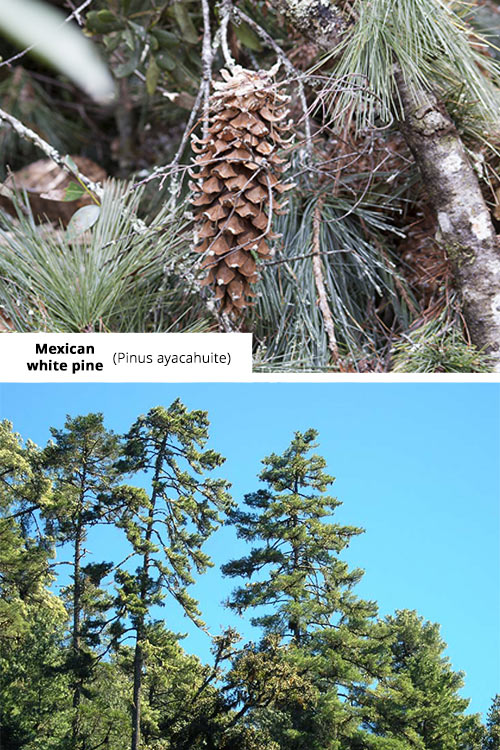
Pinus caribaea - Caribbean pine
The Caribbean Pine (Pinus caribaea) is a tall, hard pine native to the Caribbean and Central America, with the following characteristics:
- Long needles
- Large cones
- Often used for timber
- Valued for its ability to tolerate drought and grow in various environments
From coastal regions to mountainous areas, the Caribbean Pine is a versatile and resilient member of the pine tree family.
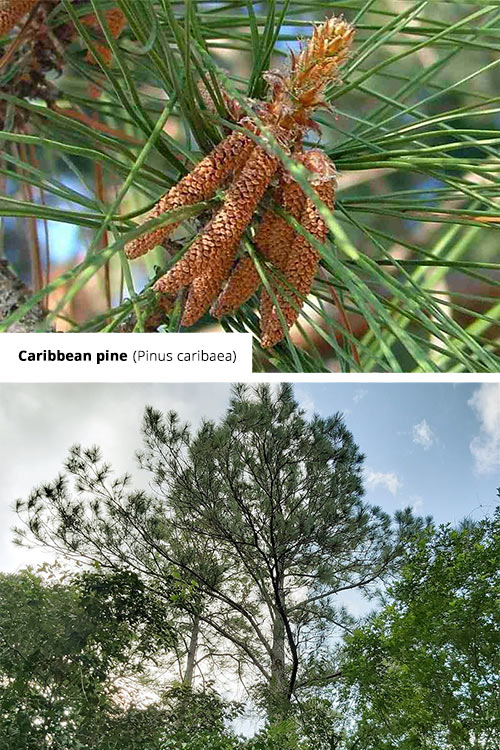
Pinus cembroides - Mexican pinyon
The Mexican Pinyon (Pinus cembroides) is a small, drought-tolerant pine native to Mexico, with the following characteristics:
- Short needles
- Small cones
- Edible pine nuts
- Dark green needles
- Small cones with reddish-brown bark
Capable of thriving in arid, rocky slopes and canyons, the Mexican Pinyon is a fascinating example of how pine trees have adapted to flourish in diverse environments and offer valuable resources.
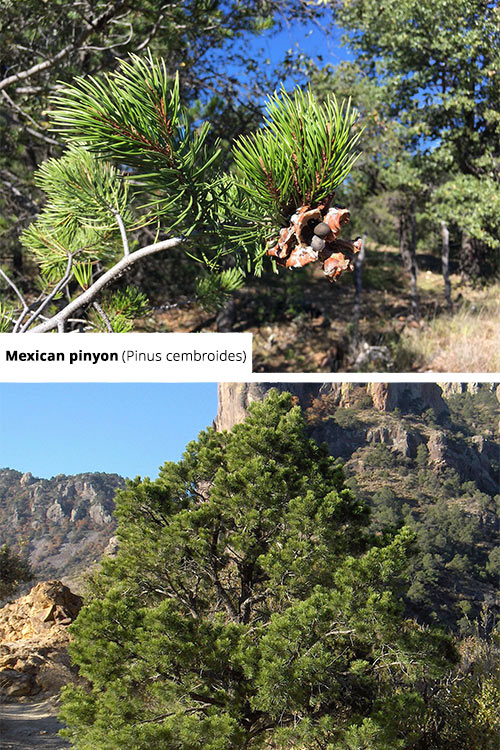
Pinus chiapensis - Chiapas white pine
The Chiapas White Pine (Pinus chiapensis) is a medium-sized, soft pine native to Mexico and Central America, with blue-green needles and small cones. This unique tree species is found in the mountains of southern Mexico and Central America, where it thrives in various environments.
With its beautiful blue-green needles and distinctive appearance, the Chiapas White Pine is a captivating member of the pine tree family.
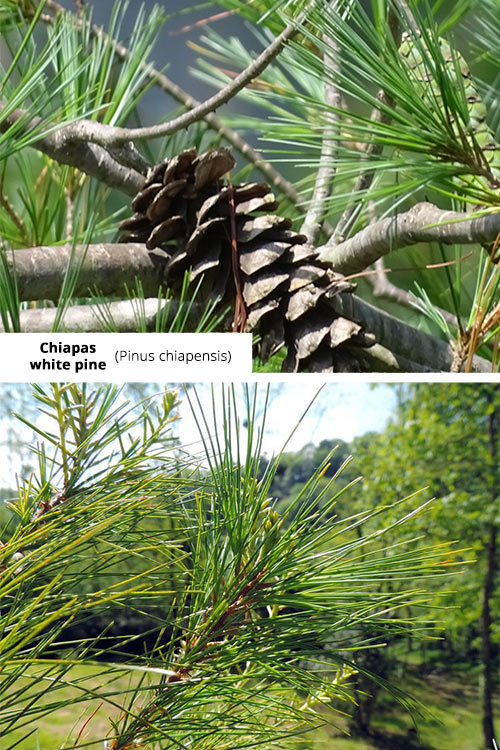
Pinus cooperi - Cooper's pine
Cooper’s Pine (Pinus cooperi) is a medium-sized, hard pine native to Mexico, with long needles and large cones. Often used for lumber, this tree species is found in the Sierra Madre Occidental region of Mexico, where it thrives in various environments.
Its unique characteristics, including its long needles and large cones, make Cooper’s Pine an important resource and an intriguing member of the pine tree family.
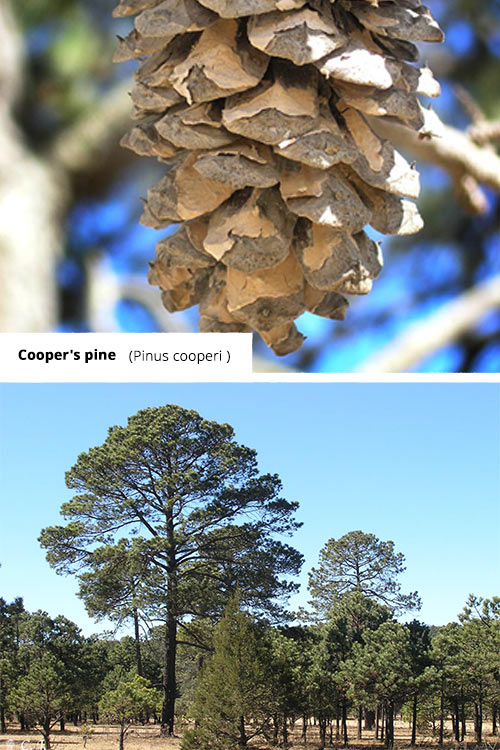
Pinus cubensis - Cuban pine
The Cuban Pine (Pinus cubensis) is a tall, hard pine native to Cuba, with long needles and large cones. Often used for timber and reforestation, this tree species is found in the eastern highlands of Cuba, where it thrives in various environments.
Its unique characteristics, including its long needles and large cones, make the Cuban Pine an essential resource and a fascinating member of the pine tree family.
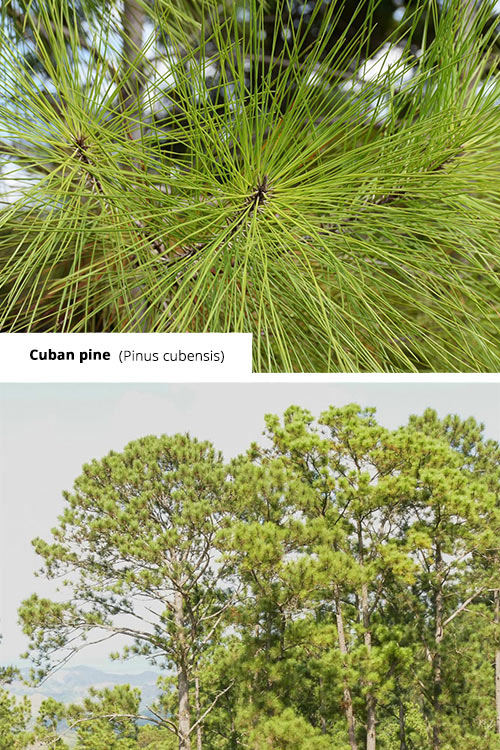
Pinus culminicola - Potosi pinyon
The Potosi Pinyon (Pinus culminicola) is a small, drought-tolerant pine native to Mexico, with short needles and small cones, producing edible pine nuts. This unique tree species is found in the mountains of northeast Mexico, where it thrives in arid, rocky slopes and canyons.
With its unique characteristics, including its short needles and small cones, the Potosi Pinyon is a fascinating example of how pine trees have adapted to flourish in diverse environments and offer valuable resources.
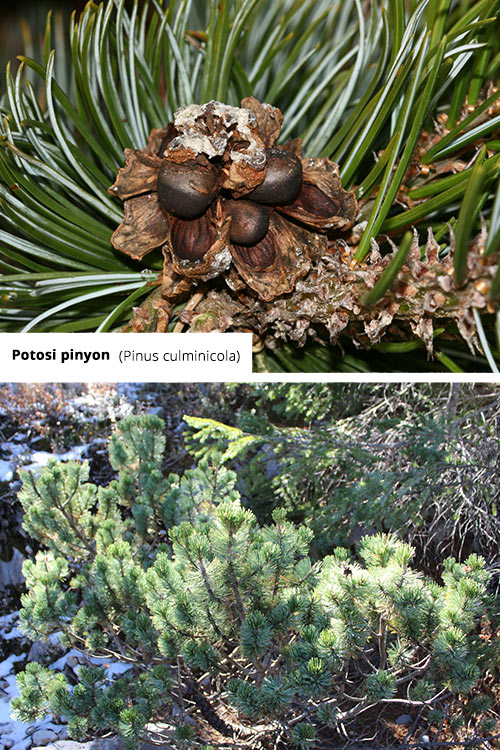
Pinus devoniana (syn. P. michoacana) - Michoacan pine
The Michoacan Pine (Pinus devoniana) is a tall, hard pine native to Mexico, with long needles and large cones, often used for lumber and reforestation. This tree species is found in the mountains of southern Mexico, where it thrives in various environments.
Its unique characteristics, including its long needles and large cones, make the Michoacan Pine an essential resource and an intriguing member of the pine tree family.
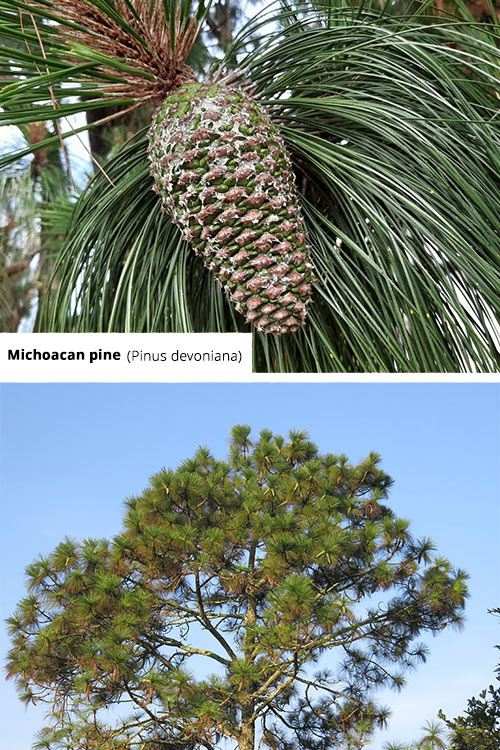
Pinus durangensis - Durango pine
The Durango Pine (Pinus durangensis) is a tall, hard pine native to Mexico, with long needles and large cones, often used for lumber and reforestation. This tree species is found in the Sierra Madre Occidental region of Mexico, where it thrives in various environments.
Its unique characteristics, including its long needles and large cones, make the Durango Pine an essential resource and an intriguing member of the pine tree family.
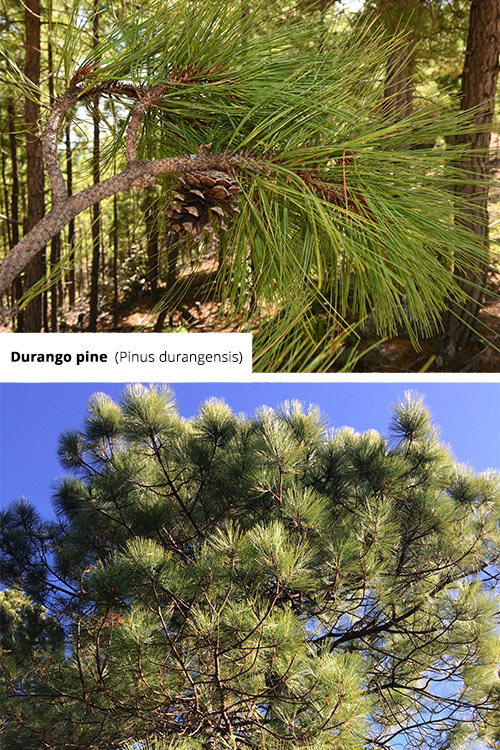
Pinus engelmannii - Apache pine
The Apache Pine (Pinus engelmannii) is a tall, hard pine native to the southwestern United States and Mexico, with long needles and large cones, often used for lumber. This tree species is found in the mountains of Colorado and extends down into Northern New Mexico, where it thrives in various environments.
Its unique characteristics, including its long needles and large cones, make the Apache Pine an essential resource and an intriguing member of the pine tree family.
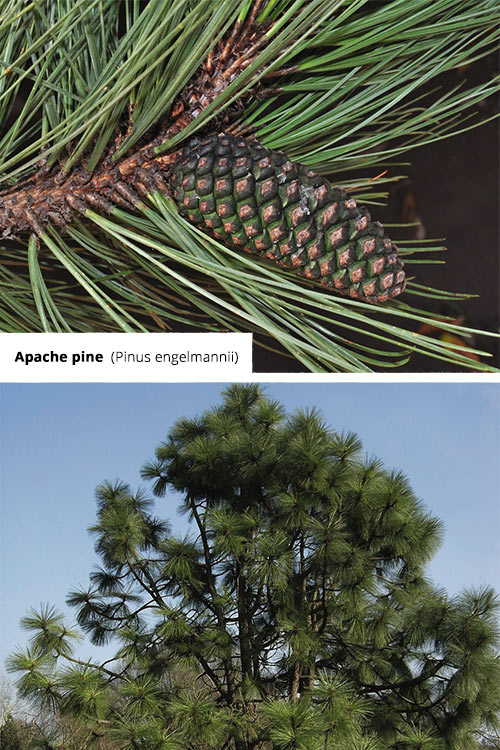
Pinus douglasiana - Douglas pine
The Douglas Pine (Pinus douglasiana) is a medium-sized, hard pine native to Mexico, with long needles and large cones, often used for lumber and landscaping. This tree species is found in the mountains of southern Mexico, where it thrives in various environments.
Its unique characteristics, including its long needles and large cones, make the Douglas Pine an essential resource and an intriguing member of the pine tree family.
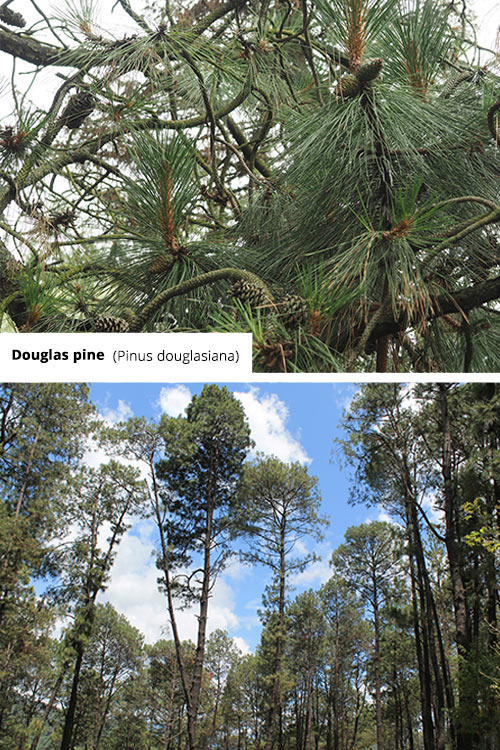
Pinus greggii - Gregg's pine
The Gregg’s Pine (Pinus greggii) is a small, drought-tolerant pine native to Mexico, with short needles and small cones, producing edible pine nuts. This unique tree species is found in the mountains and high deserts of Texas, New Mexico, and Arizona, where it thrives in various environments.
With its unique characteristics, including its short needles and small cones, the Gregg’s Pine is a fascinating example of how pine trees have adapted to flourish in diverse environments and offer valuable resources.
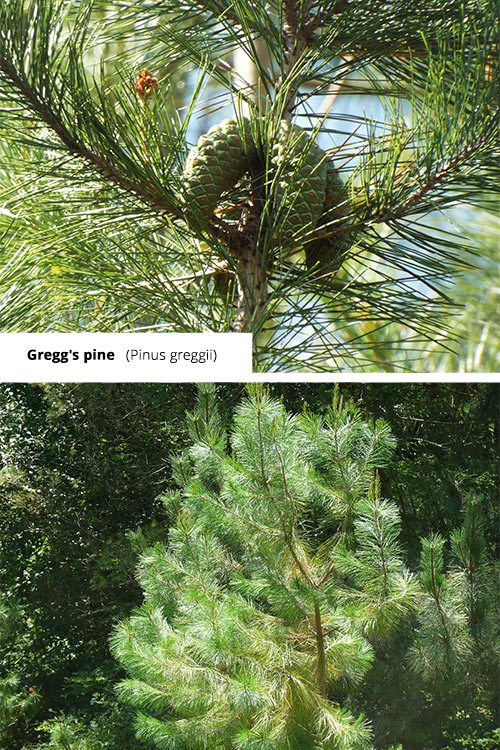
Pinus hartwegii - Hartweg's pine
Pinus hartwegii (syn. P. rudis, P. donnell-smithii), Hartweg’s pine, the Mexican mountain pine, or pino de las alturas, is a pine native to the mountains of Mexico and Central America east to Honduras. It is named after Karl Theodor Hartweg, who described it in 1838.
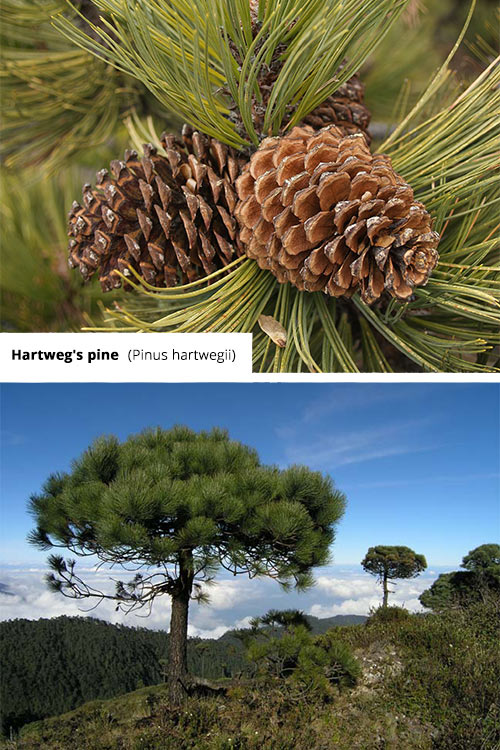
Pinus herrerae - Herrera's pine
Herrera’s pine, scientifically known as Pinus herrerae, is a rare species native to Mexico. This intriguing tree shares some similarities with the bristlecone pine, such as its long needles and large cones, setting it apart from other pine species. The rarity of Herrera’s pine makes it a fascinating species to study and appreciate, serving as a reminder of the vast diversity found within the world of pine trees.
Herrera’s pine is a unique species that is not found anywhere else in the world.
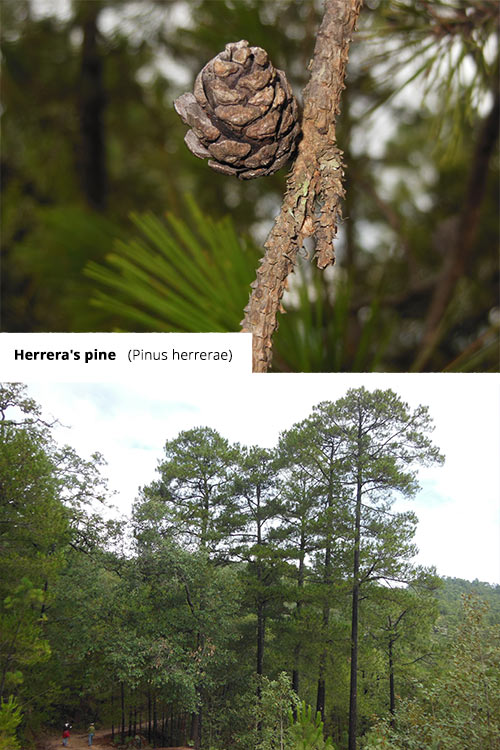
Pinus jaliscana - Jalisco pine
Venturing further into the fascinating world of pine trees, we encounter the Jalisco pine, or Pinus jaliscana, a medium-sized tree native to western Mexico. With its long needles and large cones, the Jalisco pine shares some similarities with the sand pine, another species found in the Americas.
The unique characteristics of the Jalisco pine further highlight the incredible diversity found within the pine family, as we continue our exploration of these remarkable trees.
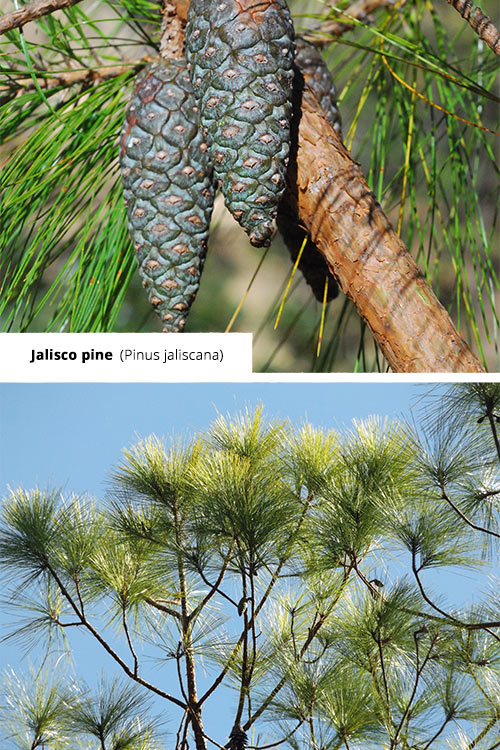
Pinus johannis - Johann's pinyon
Johann’s pinyon, or Pinus johannis, is a small tree native to Mexico, characterized by its short needles and small cones. This charming little tree stands as a testament to the incredible range of sizes and shapes found within the world of pine trees.
As we continue our journey through the diverse world of pines, we encounter even more fascinating species, each with its own unique attributes and native range.
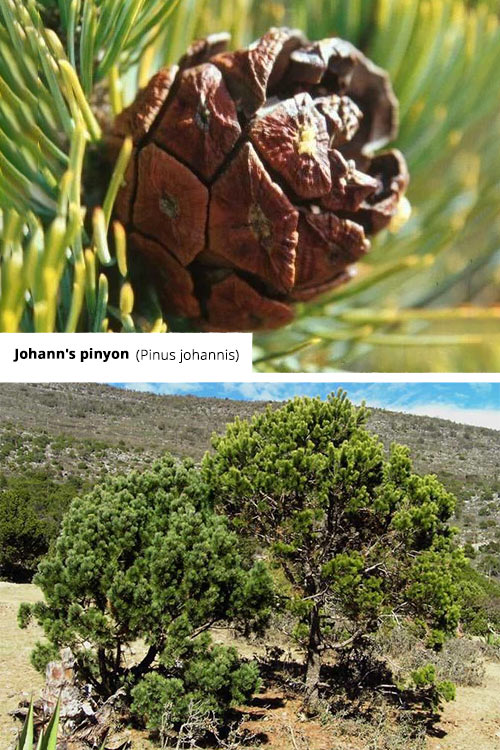
Pinus lawsonii - Lawson's pine
Lawson’s pine, scientifically named Pinus lawsonii, is a rare species native to Mexico. This exceptional tree boasts long needles and large cones, making it an impressive sight to behold.
The rarity of Lawson’s pine serves as a reminder of the incredible diversity found within the pine family and underscores the importance of preserving these unique species for future generations to enjoy.
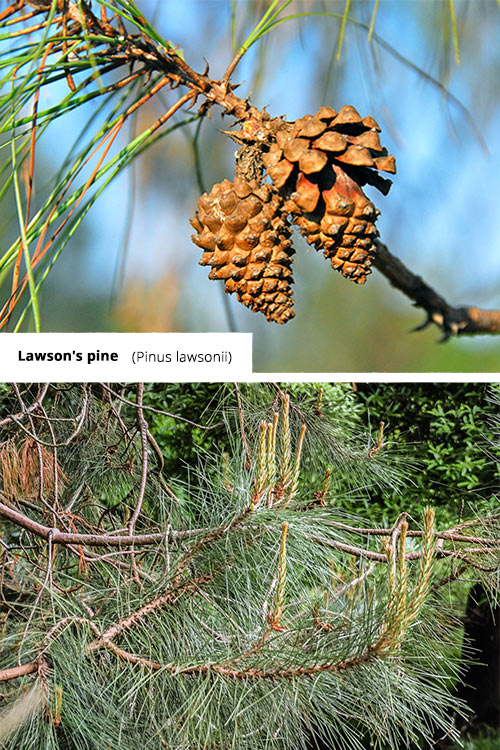
Pinus leiophylla - Chihuahua pine
The Chihuahua pine, scientifically known as Pinus leiophylla, is a medium-sized tree native to Mexico and the southwestern United States. This striking tree is adorned with long needles and large cones, much like its relative, the ponderosa pine tree.
The Chihuahua pine’s distinctive characteristics and native range further demonstrate the incredible variety found within the pine family, as we continue to explore the different species that make up this diverse group of trees.
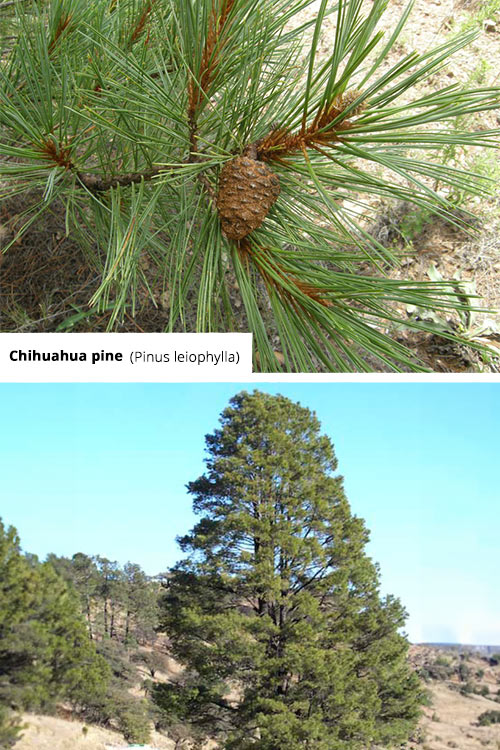
Pinus lumholtzii - Lumholtz's pine
Lumholtz’s pine, or Pinus lumholtzii, is a small tree native to Mexico, characterized by its short needles and small cones. This charming species, while not as well-known as some of its larger relatives like the ponderosa pine tree, the limber pine, and the lodgepole pine, contributes to the incredible diversity found within the world of pine trees.
As we continue our journey through the fascinating variety of pines, we encounter even more unique species, each with its own distinct features and native ranges.
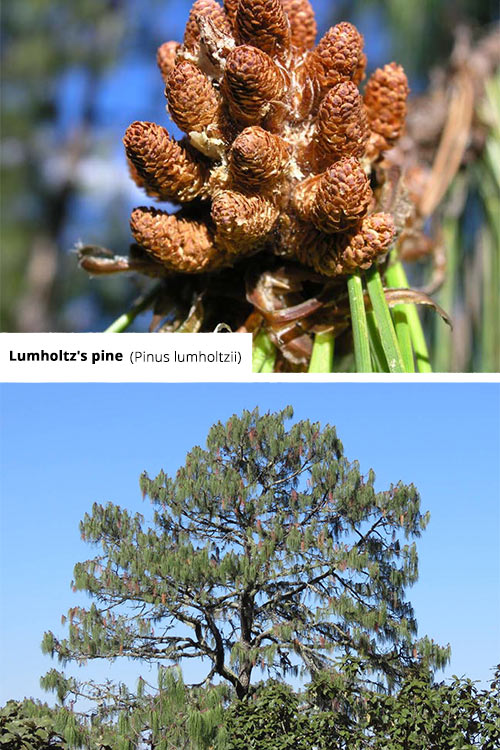
Pinus luzmariae
Pinus luzmariae is a rare species of pine tree native to Mexico, characterized by its long needles and large cones. This exceptional tree stands as a testament to the incredible diversity found within the pine family, as we continue our exploration of the many fascinating species that grace our planet.
With its unique characteristics and native range, Pinus luzmariae serves as a reminder of the importance of preserving these remarkable trees for future generations to enjoy.
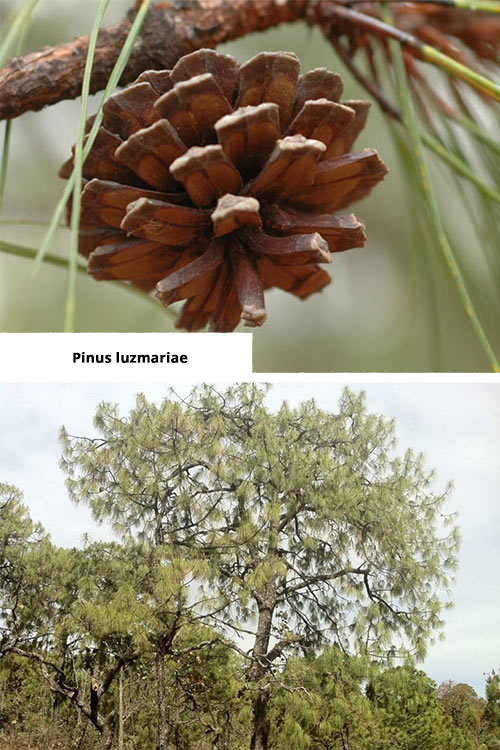
Pinus maximartinezii - Big-cone pinyon
Big-cone pinyon, or Pinus maximartinezii, is a small tree native to Mexico, distinctive for its short needles and large cones. This intriguing species adds to the incredible diversity found within the world of pine trees, showcasing the vast range of sizes and shapes that these trees can take.
As we continue our journey through the diverse world of pines, we encounter even more fascinating species, each with its own unique attributes and native ranges.
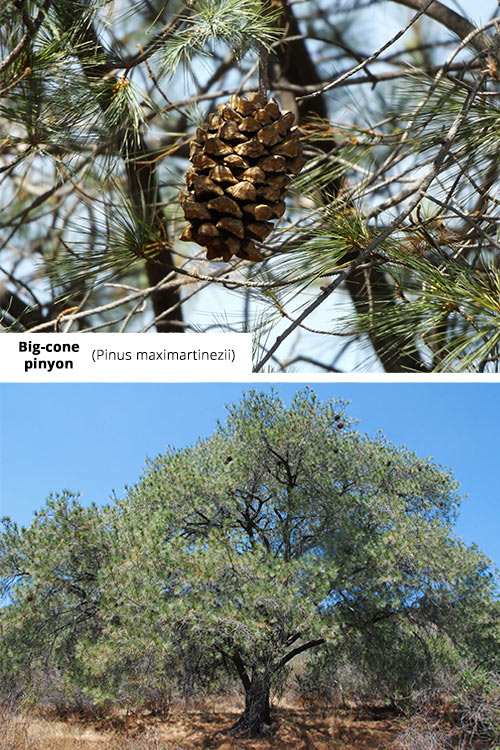
Pinus maximinoi (syn. P. tenuifolia) - Thinleaf pine
Thinleaf pine, scientifically known as Pinus maximinoi, is a medium-sized tree native to Mexico, characterized by its long needles and large cones. This striking tree further highlights the incredible diversity found within the pine family, as we continue our exploration of these remarkable trees.
With its unique characteristics and native range, Thinleaf pine serves as a reminder of the importance of preserving these unique species for future generations to enjoy.
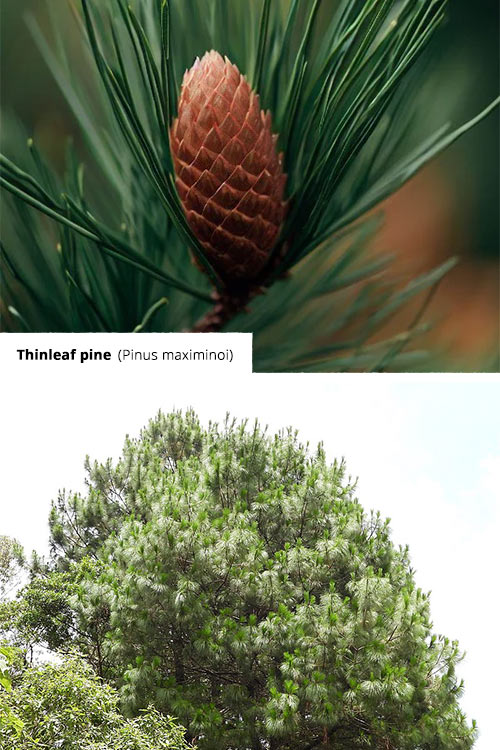
Pinus montezumae - Montezuma pine
The majestic Montezuma pine, or Pinus montezumae, is a large tree native to Mexico and Central America, boasting long needles and large cones. This impressive species stands as a testament to the incredible diversity found within the world of pine trees, contributing to the vast range of sizes and shapes that these trees can take.
As we continue our journey through the diverse world of pines, we encounter even more fascinating species, each with its own unique attributes and native ranges.
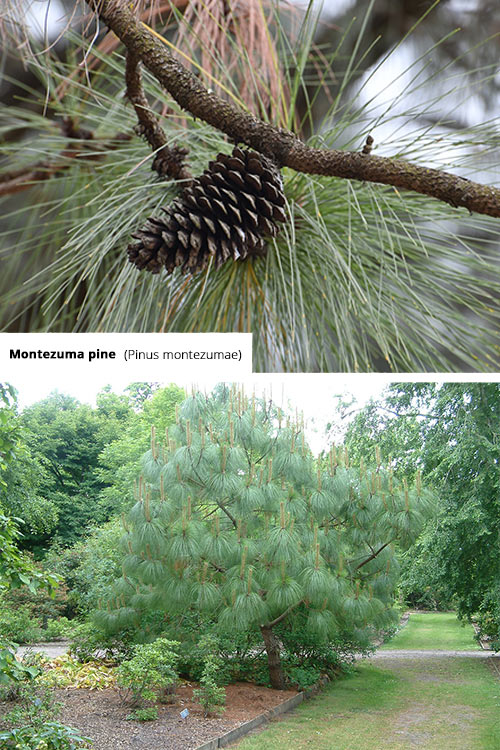
Pinus nelsonii - Nelson's pinyon
Nelson’s pinyon, scientifically known as Pinus nelsonii, is a small tree native to Mexico, characterized by its short needles and small cones. This charming species, while not as well-known as some of its larger relatives like the ponderosa pine tree, contributes to the incredible diversity found within the world of pine trees.
As we continue our journey through the fascinating variety of pines, we encounter even more unique species, each with its own distinct features and native ranges.
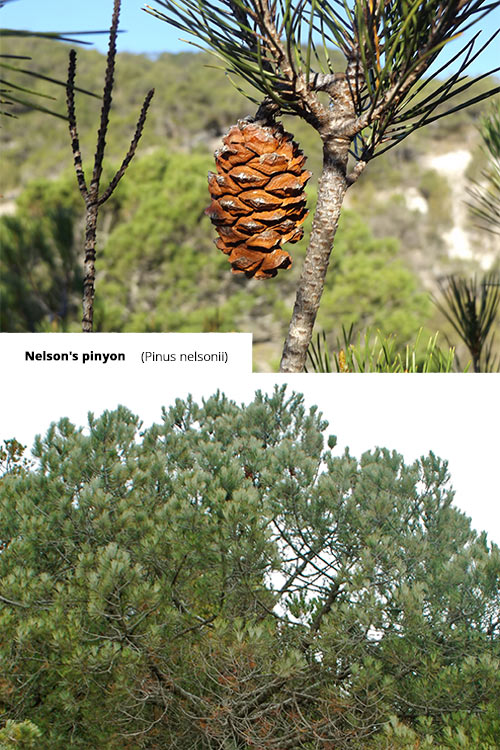
Pinus occidentalis - Hispaniolan pine
Hispaniolan pine, or Pinus occidentalis, is a medium-sized tree native to the Caribbean region, characterized by its long needles and large cones. This striking tree stands as a testament to the incredible diversity found within the world of pine trees, contributing to the vast range of sizes and shapes that these trees can take.
As we continue our journey through the diverse world of pines, we encounter even more fascinating species, each with its own unique attributes and native ranges.
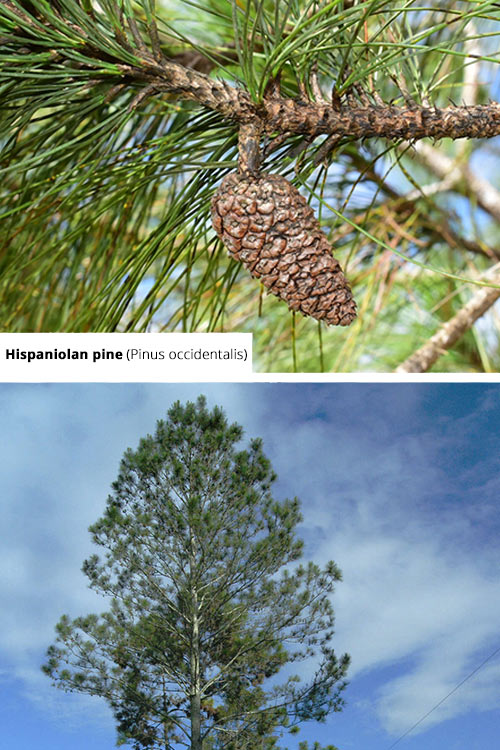
Pinus oocarpa - Egg-cone pine
Egg-cone pine, or Pinus oocarpa, is a medium-sized tree native to Mexico and Central America, distinctive for its long needles and egg-shaped cones. This fascinating species adds to the incredible diversity found within the world of pine trees, showcasing the vast range of sizes and shapes that these trees can take.
As we continue our journey through the diverse world of pines, we encounter even more fascinating species, each with its own unique attributes and native ranges.
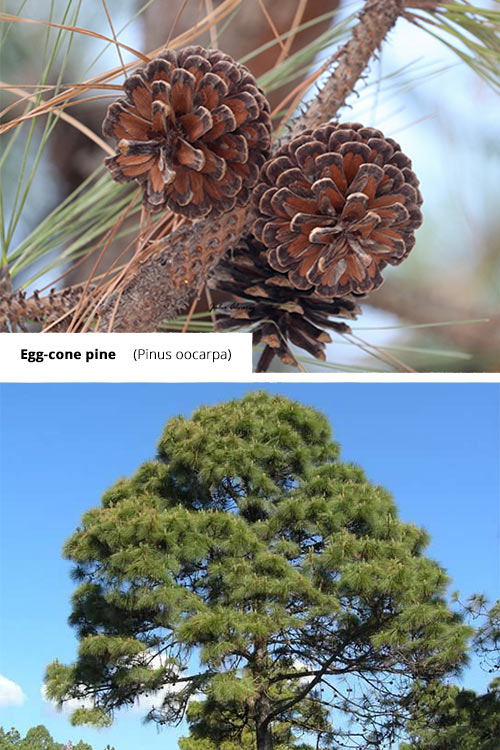
Pinus patula - Patula pine
Patula pine, scientifically known as Pinus patula, is a medium-sized tree native to Mexico, characterized by its long needles bundled in groups of 3 to 5 and sizeable cones. This impressive tree further highlights the incredible diversity found within the pine family, as we continue our exploration of these remarkable trees.
With its unique characteristics and native range, the Patula pine serves as a reminder of the importance of preserving these unique species for future generations to enjoy.
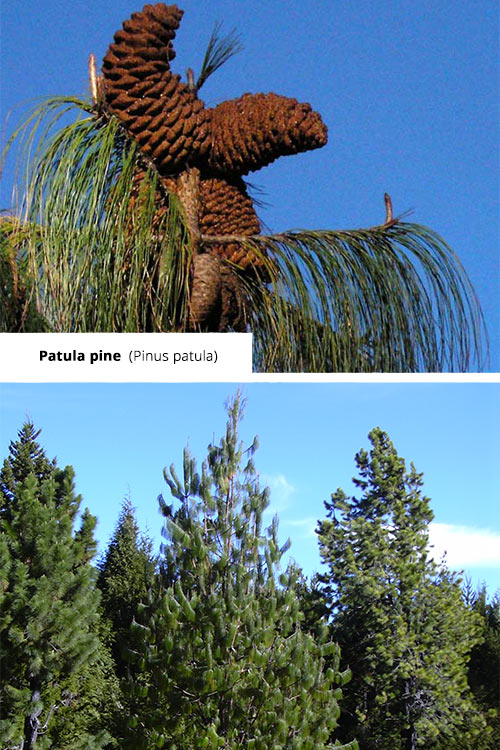
Pinus orizabensis - Orizaba pinyon
Orizaba pinyon, or Pinus orizabensis, is a small tree native to Mexico, characterized by its short needles and small cones. This charming species, while not as well-known as some of its larger relatives like the ponderosa pine tree, contributes to the incredible diversity found within the world of pine trees.
As we continue our journey through the fascinating variety of pines, we encounter even more unique species, each with its own distinct features and native ranges.
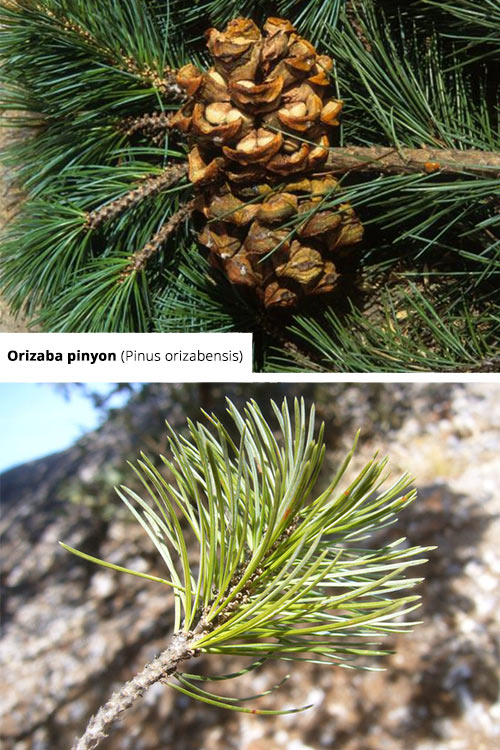
Pinus pinceana - Weeping pinyon
Weeping pinyon, or Pinus pinceana, is a small tree native to Mexico, characterized by its curved seed cones, long needle-like leaves, and branches extending along the length of the trunk. This charming species, while not as well-known as some of its larger relatives like the ponderosa pine tree, contributes to the incredible diversity found within the world of pine trees.
As we continue our journey through the fascinating variety of pines, we encounter even more unique species, each with its own distinct features and native ranges.
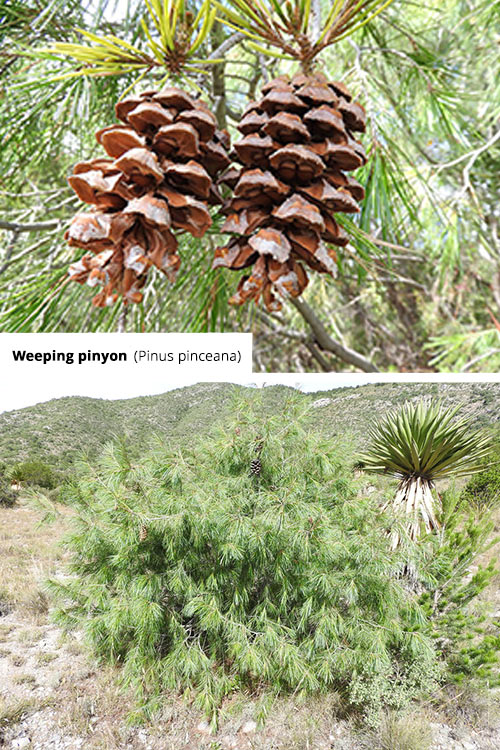
Pinus praetermissa - McVaugh's pine
McVaugh’s pine, scientifically known as Pinus praetermissa, is a rare species native to Mexico, characterized by its long needles and large cones. This exceptional tree stands as a testament to the incredible diversity found within the pine family, including the Austrian pine, the Scots pine, and the Virginia pine, as we continue our exploration of the many fascinating species that grace our planet.
With its unique characteristics and native range, McVaugh’s pine serves as a reminder of the importance of preserving these remarkable trees for future generations to enjoy.
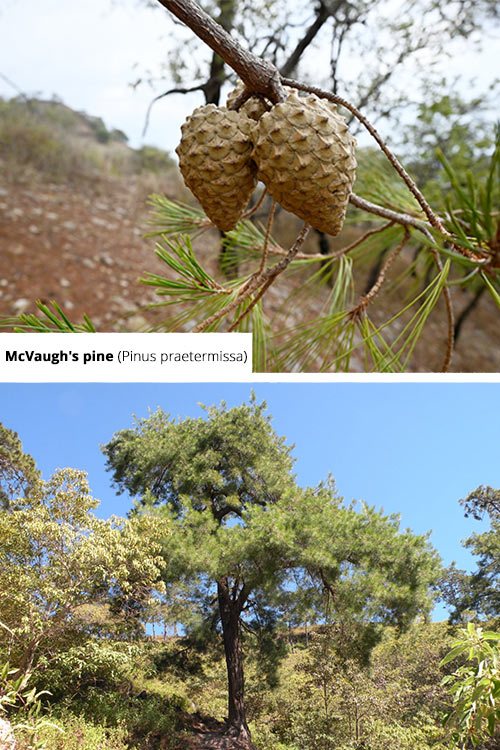
Pinus pringlei - Pringle's pine
Pringle’s pine, scientifically known as Pinus pringlei, is a medium-sized tree native to Mexico, characterized by its long needles and large cones. This striking tree further highlights the incredible diversity found within the pine family, including species like the pitch pine, as we continue our exploration of these remarkable trees.
With its unique characteristics and native range, Pringle’s pine serves as a reminder of the importance of preserving these unique species for future generations to enjoy.
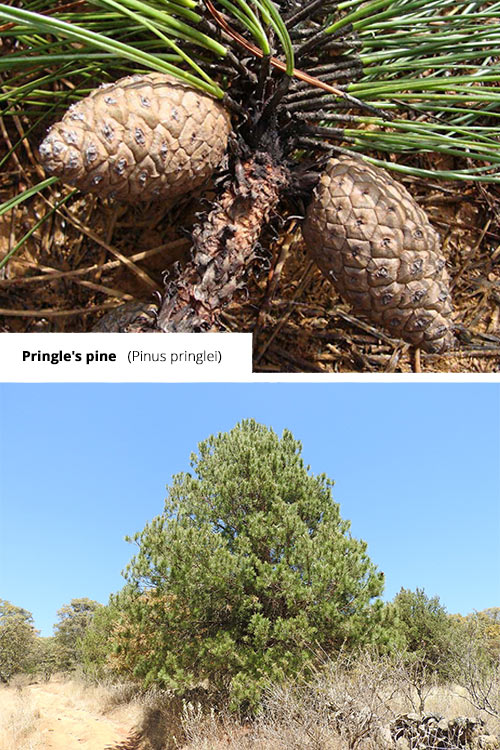
Pinus pseudostrobus - Smooth-bark Mexican pine
Smooth-bark Mexican pine, or Pinus pseudostrobus, is a medium-sized tree native to Mexico, characterized by its long needles and large cones. This impressive tree stands as a testament to the incredible diversity found within the world of pine trees, contributing to the vast range of sizes and shapes that these trees can take.
As we continue our journey through the diverse world of pines, we encounter even more fascinating species, each with its own unique attributes and native ranges.
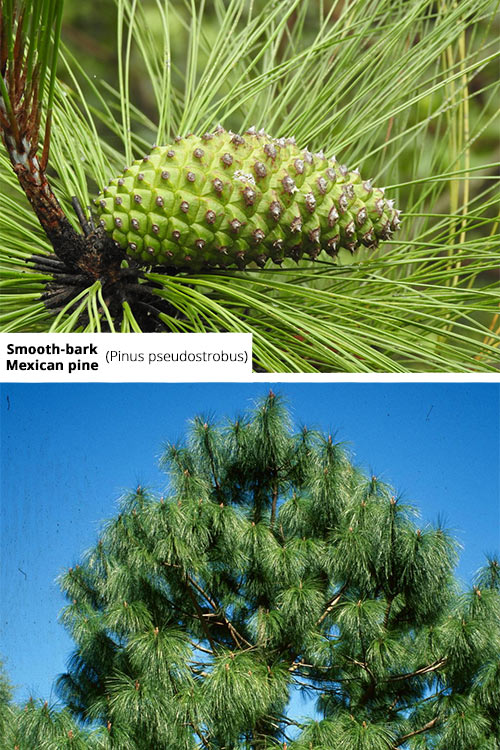
Pinus quadrifolia - Parry pinyon
Parry pinyon, scientifically known as Pinus quadrifolia, is a small tree native to the southwestern United States, characterized by its short needles and small cones. This charming species, while not as well-known as some of its larger relatives like the ponderosa pine tree, contributes to the incredible diversity found within the world of pine trees.
As we continue our journey through the fascinating variety of pines, we encounter even more unique species, each with its own distinct features and native ranges.
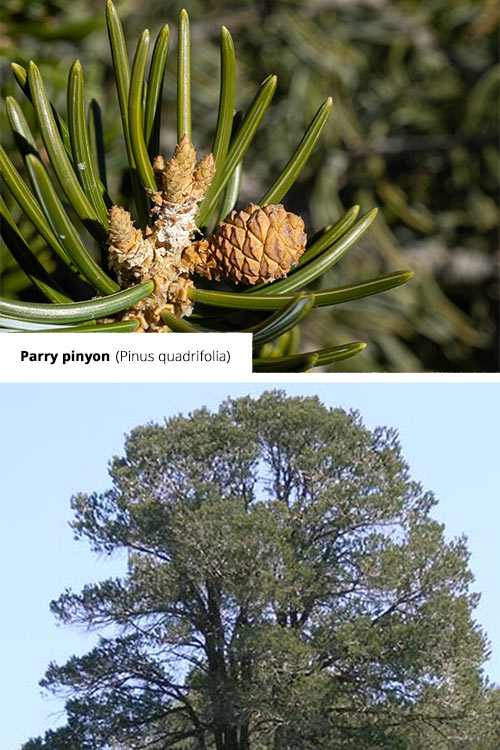
Pinus rzedowskii - Rzedowskii's pine
Rzedowskii’s pine, scientifically known as Pinus rzedowskii, is a rare species native to Mexico, characterized by its long needles and large cones. This exceptional tree stands as a testament to the incredible diversity found within the pine family, as we continue our exploration of the many fascinating species that grace our planet.
With its unique characteristics and native range, Rzedowskii’s pine serves as a reminder of the importance of preserving these remarkable trees for future generations to enjoy.
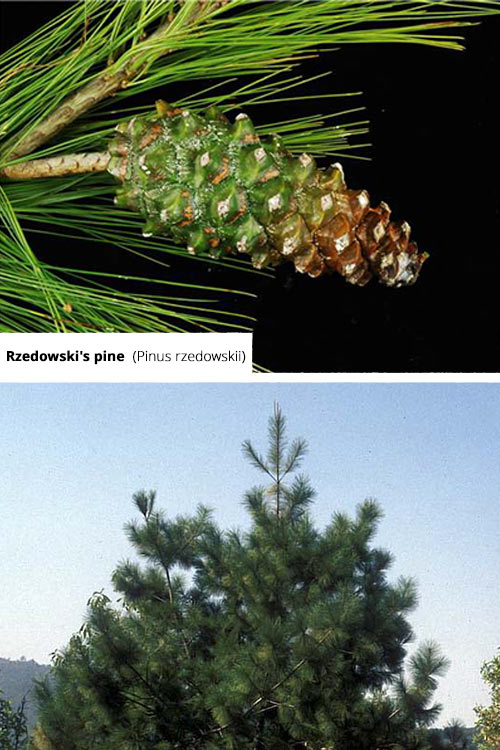
Pinus strobiformis - Chihuahua white pine
Chihuahua white pine, or Pinus strobiformis, is a medium-sized tree native to Mexico and the southwestern United States, characterized by its small, blue-green, soft leaves growing in groups of five and small, creamy-colored cones that measure up to two and a half inches in length. This striking tree stands as a testament to the incredible diversity found within the world of pine trees, including the western white pine, contributing to the vast range of sizes and shapes that these trees can take.
As we continue our journey through the diverse world of pines, we encounter even more fascinating species, each with its own unique attributes and native ranges.
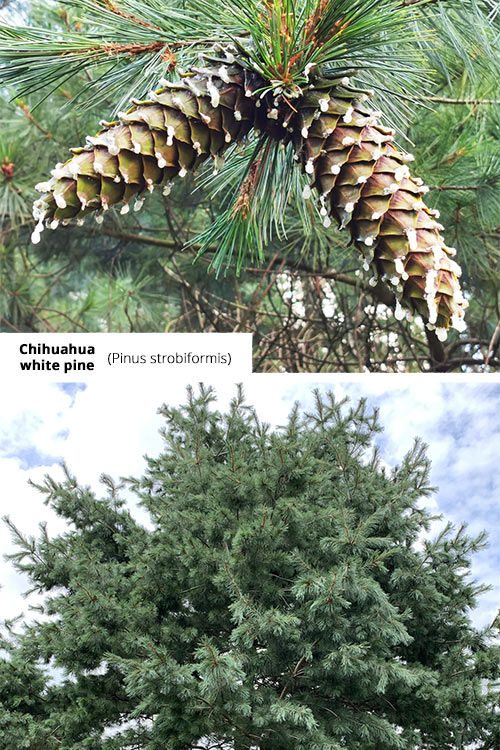
Pinus tecunumanii - Tecun Uman pine
Tecun Uman pine, scientifically known as Pinus tecunumanii, is a medium-sized tree native to Central America, characterized by its long needles and large cones. This impressive tree further highlights the incredible diversity found within the pine family, as we continue our exploration of these remarkable trees.
With its unique characteristics and native range, Tecun Uman pine serves as a reminder of the importance of preserving these unique species for future generations to enjoy.
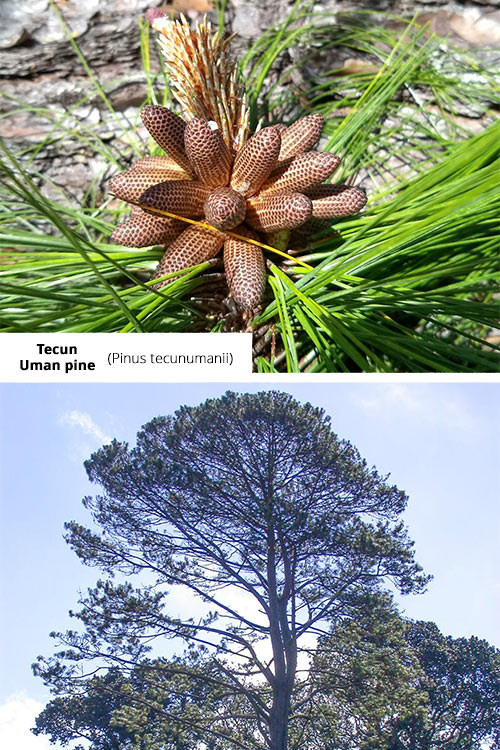
Pinus teocote - Teocote pine
Teocote pine, scientifically known as Pinus teocote, is a medium-sized tree native to Mexico, characterized by its long needles and large cones. This striking tree further highlights the incredible diversity found within the pine family, as we continue our exploration of these remarkable trees.
With its unique characteristics and native range, Teocote pine serves as a reminder of the importance of preserving these unique species for future generations to enjoy.
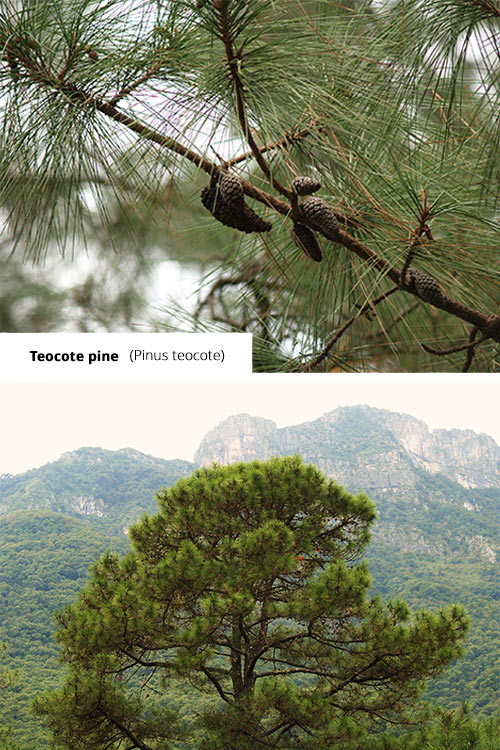
Pinus tropicalis - Tropical pine
Tropical pine, scientifically known as Pinus tropicalis, is a medium-sized tree native to the Caribbean region, characterized by its long needles and large cones. This impressive tree stands as a testament to the incredible diversity found within the world of pine trees, contributing to the vast range of sizes and shapes that these trees can take.
As we continue our journey through the diverse world of pines, we encounter even more fascinating species, each with its own unique attributes and native ranges.
